Learn to make a classic-style Japanese rice omelette called Omurice. It’s a home-cooking staple in Japan adored by people of all ages. In my recipe, I’ll teach you how to make a perfectly creamy and custardy omelette to wrap around savory chicken rice. {Vegetarian-adaptable}
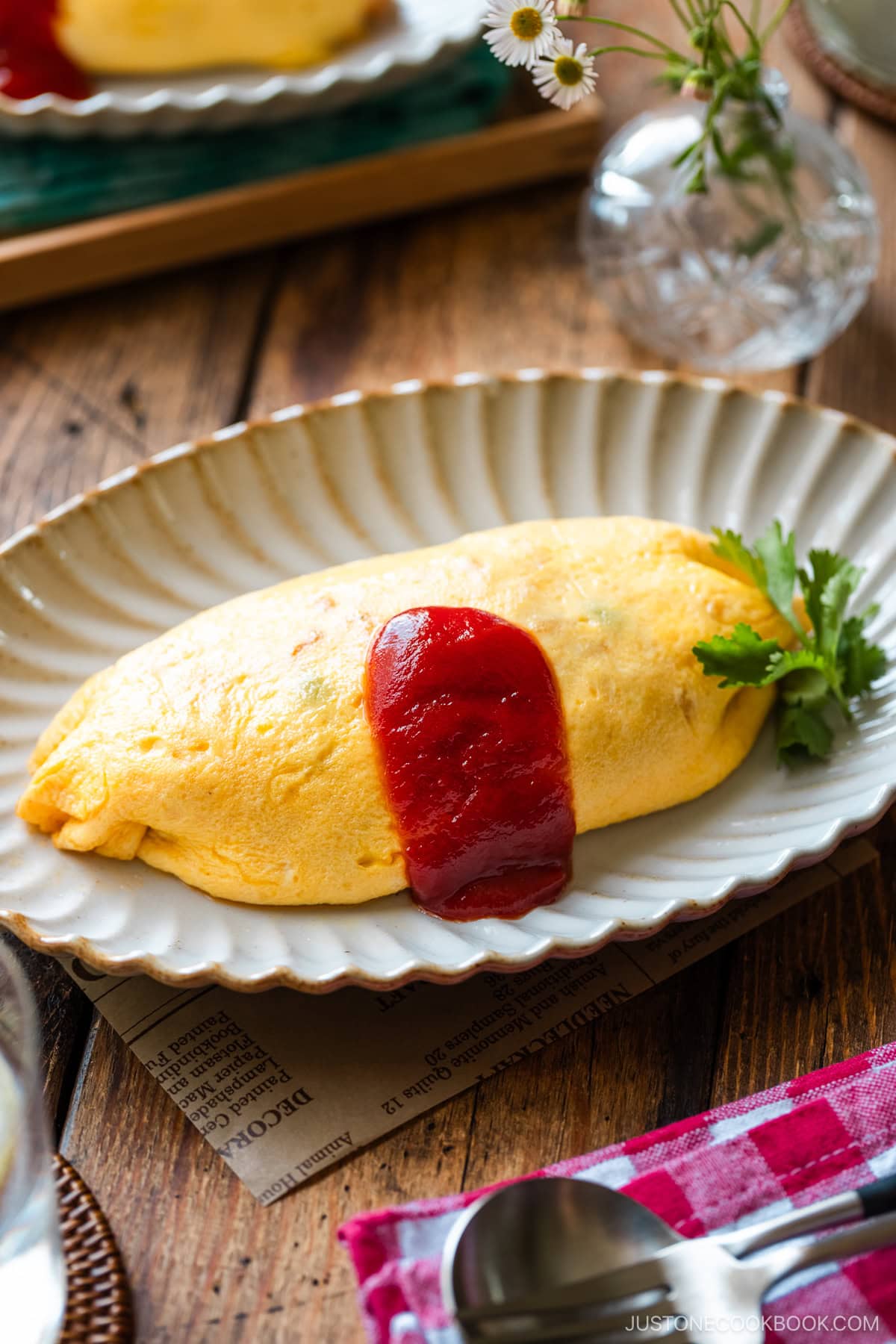
Today, I’m sharing my recipe for the classic-style Japanese rice omelette called omurice (オムライス). My children absolutely loved eating this delicious dish when they were little…and they still do! Young and old alike in Japan feel the same way. Sitting down to a plate of omurice feels like a warm hug; it’s a familiar, everyday meal that brings back childhood memories of mom’s cooking.
All across Japan, you can find this popular yōshoku (Western-style Japanese cuisine) dish in family restaurants, diners, and home kitchens. I’ll teach you my tips and techniques to make restaurant-quality omurice at home that’s tender, full of flavor, and oh-so-comforting!
Table of Contents
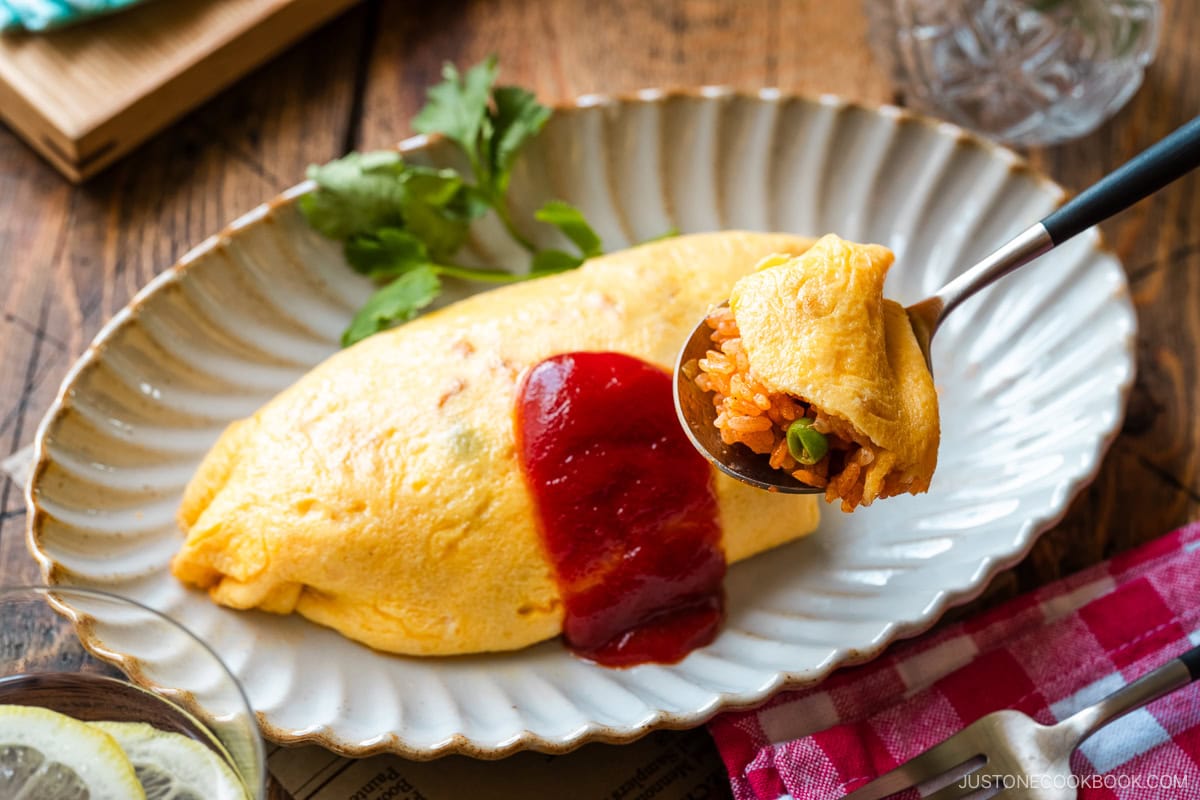
What is Omurice?
Japanese omurice (オムライス) is a thin, soft-cooked omelette wrapped around seasoned Japanese ketchup rice (ケチャップライス) or chicken rice (チキンライス). The name itself is a catchy Japanese loanword that blends “omelette” and “rice.”
This Western-style dish is unique to Japan, as it doesn’t exist in American or European cuisine. Several restaurants in Japan claim to have created omurice in the early 1900s. However, it was in 1925 that a chef in Osaka at a Western-style diner called Hokkyokusei created a dish very similar to the omurice that we know and love today.
Why You’ll Love This Recipe
- Creamy texture — Omurice is all about the soft-scrambled and tender omelette. I’ll teach you how to fry the eggs evenly so they’re creamy and custardy, just like a classic French omelette.
- Quick to make — You can cook it from start to finish in less than 30 minutes.
- Affordable and practical — It uses common staple ingredients from your fridge, freezer, and pantry.
- Kid-friendly — Kids love the savory ketchup flavor of the rice and the soft omelette texture.
- Flexible — Substitute any protein and vegetables from your fridge in the seasoned rice (see below for ideas).
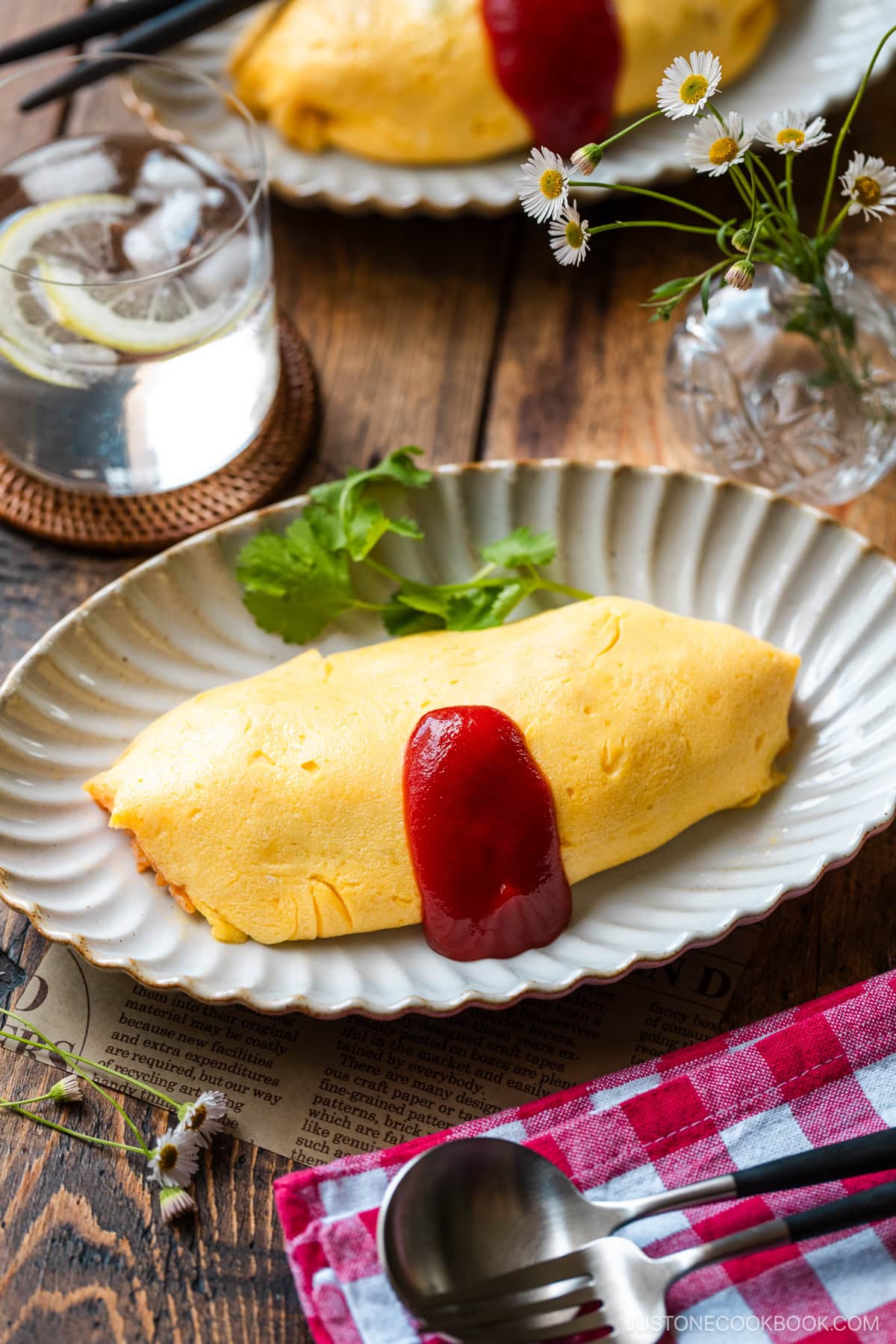
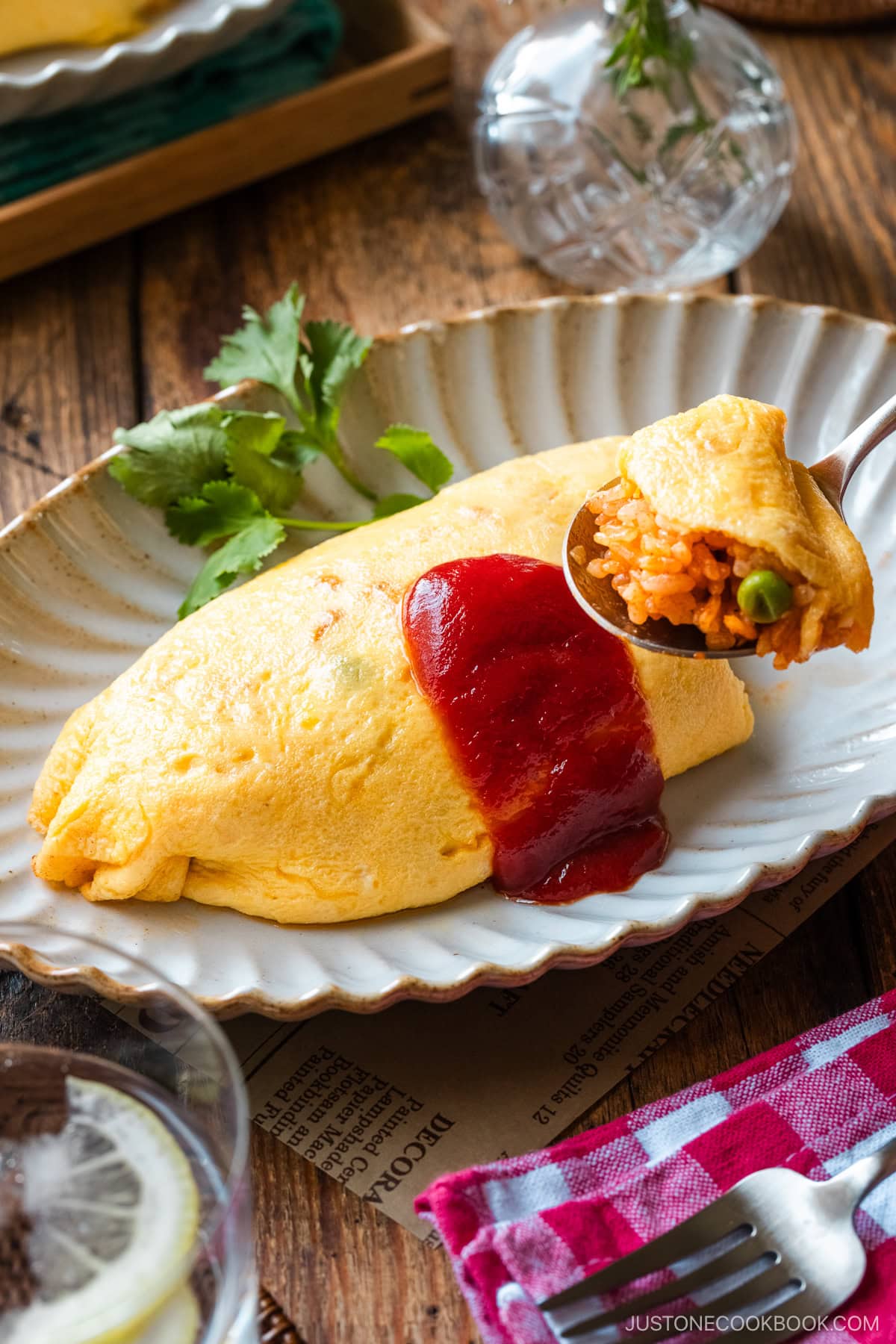
Ingredients for Omurice
You‘ll need eggs, rice, and ketchup to make the classic version, but I‘ll suggest some creative substitutions later.
- Large eggs
- Cooked Japanese short-grain rice — warm; you can reheat frozen rice if you have it
- Chicken thigh — stays juicier and more flavorful compared to chicken breast
- Onion
- Green peas
- Ketchup — the classic seasoning for chicken rice (ketchup rice); I highly recommend KAGOME brand Japanese ketchup
- Worcestershire sauce — adds complexity to the rice; you can substitute it with tonkatsu sauce or soy sauce
- Butter — adds a rich and creamy texture to the rice and omelette
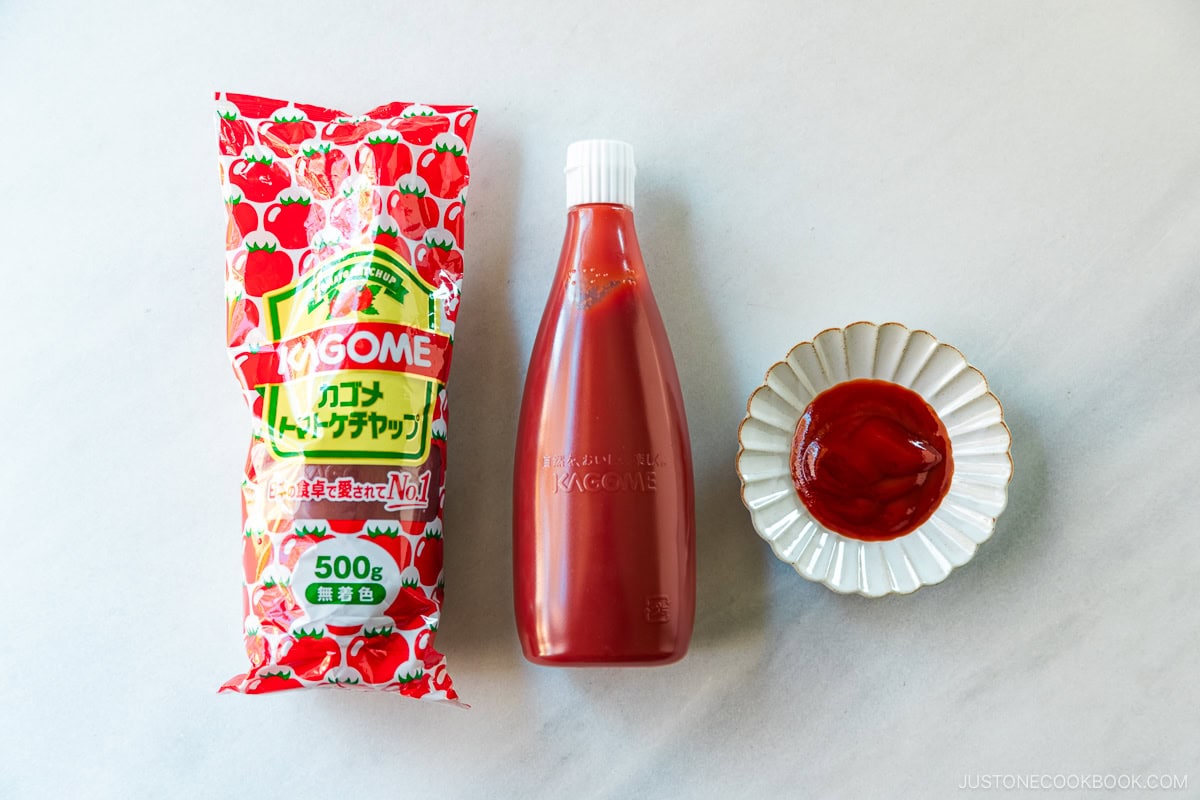
Substitution Tips and Variations
- Swap out the protein in the chicken rice with bacon, chashu pork, ham, shrimp, baked or fried tofu, and edamame—or skip it all together.
- While ketchup-flavored rice is classic, you can change up the seasoning any way you like. Try using soy sauce, simple salt and pepper, curry powder, or garlic.
- Instead of a pan, you can use your electric rice cooker to make my Rice Cooker Chicken Rice or seasoned mixed rice in the style of takikomi gohan with great results.
- Try a different sauce. Japanese love demi-glace omurice topped with demi-glace sauce, hambagu omurice with Japanese hamburger steak and sauce, hayashi omurice with hayashi rice sauce, curry omurice using Japanese curry, and cream omurice with a bechamel sauce. You could even drizzle oyster sauce on top.
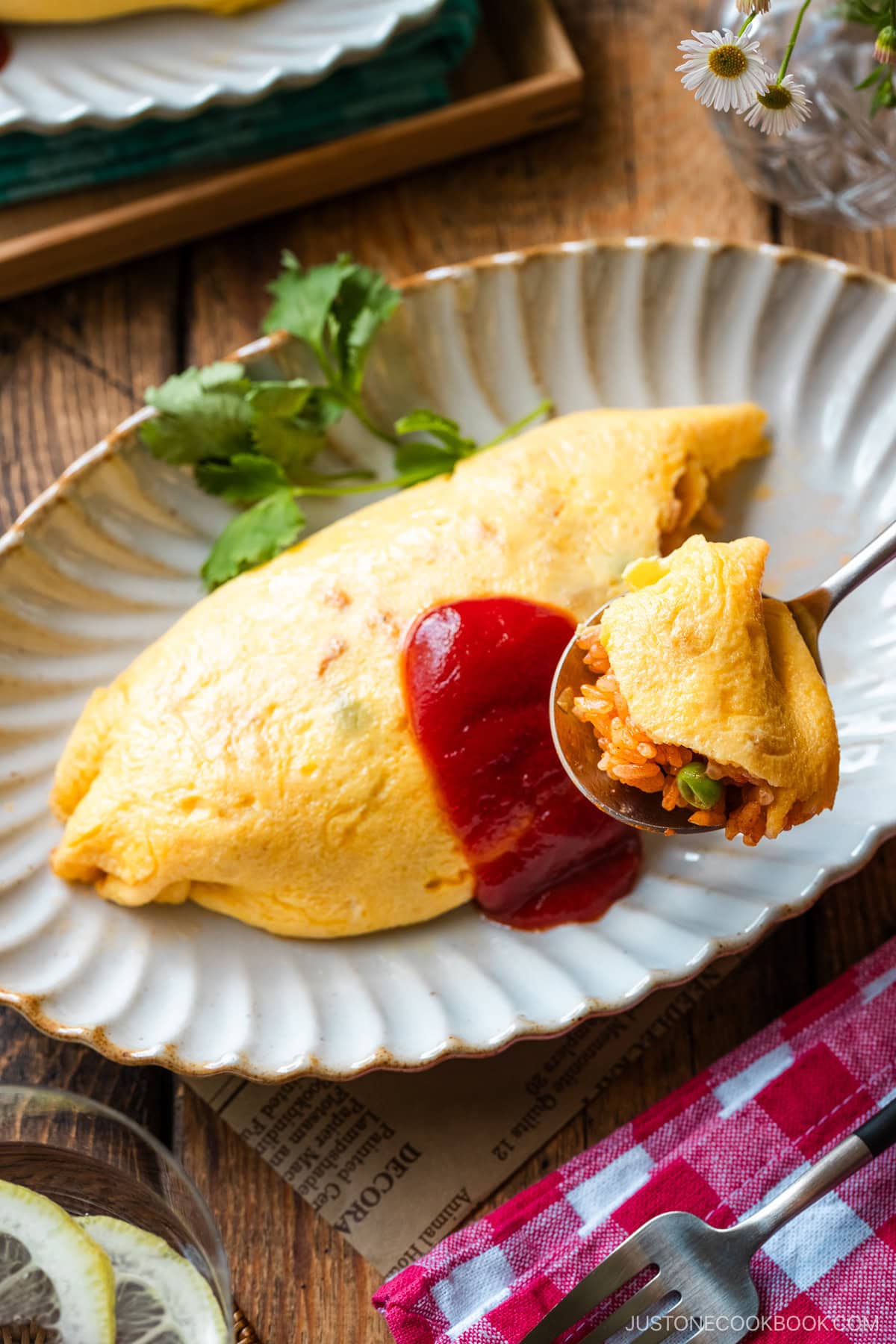
How to Make the Best Omurice
Cooking the egg goes very quickly. Be sure to follow my techniques in the next section for a creamy and soft-scrambled texture.
- Cook the chicken rice: Stir-fry the chicken and onion, then season them with ketchup. Let the excess moisture evaporate first, then add the steamed rice. Toss to combine and set aside. Alternatively, you can make my Rice Cooker Chicken Rice ahead of time and freeze individual portions so you can start making an omelette right away!
- Cook the omelette: Beat the eggs and salt and strain them through a fine-mesh strainer. Melt the butter in a frying pan and add the egg mixture. Stir the eggs constantly with a pair of chopsticks while you shake the pan to make soft, small curds.
- Assemble the omurice: When the eggs are half-cooked, place the chicken rice in the center of the omelette. Move the pan to a wet cloth to cool it. Wrap both sides of the omelette around the rice in an oval shape. Invert the omurice onto a plate and fix the shape with a paper towel. Pour the sauce or drizzle a zigzag pattern of ketchup onto the omurice.
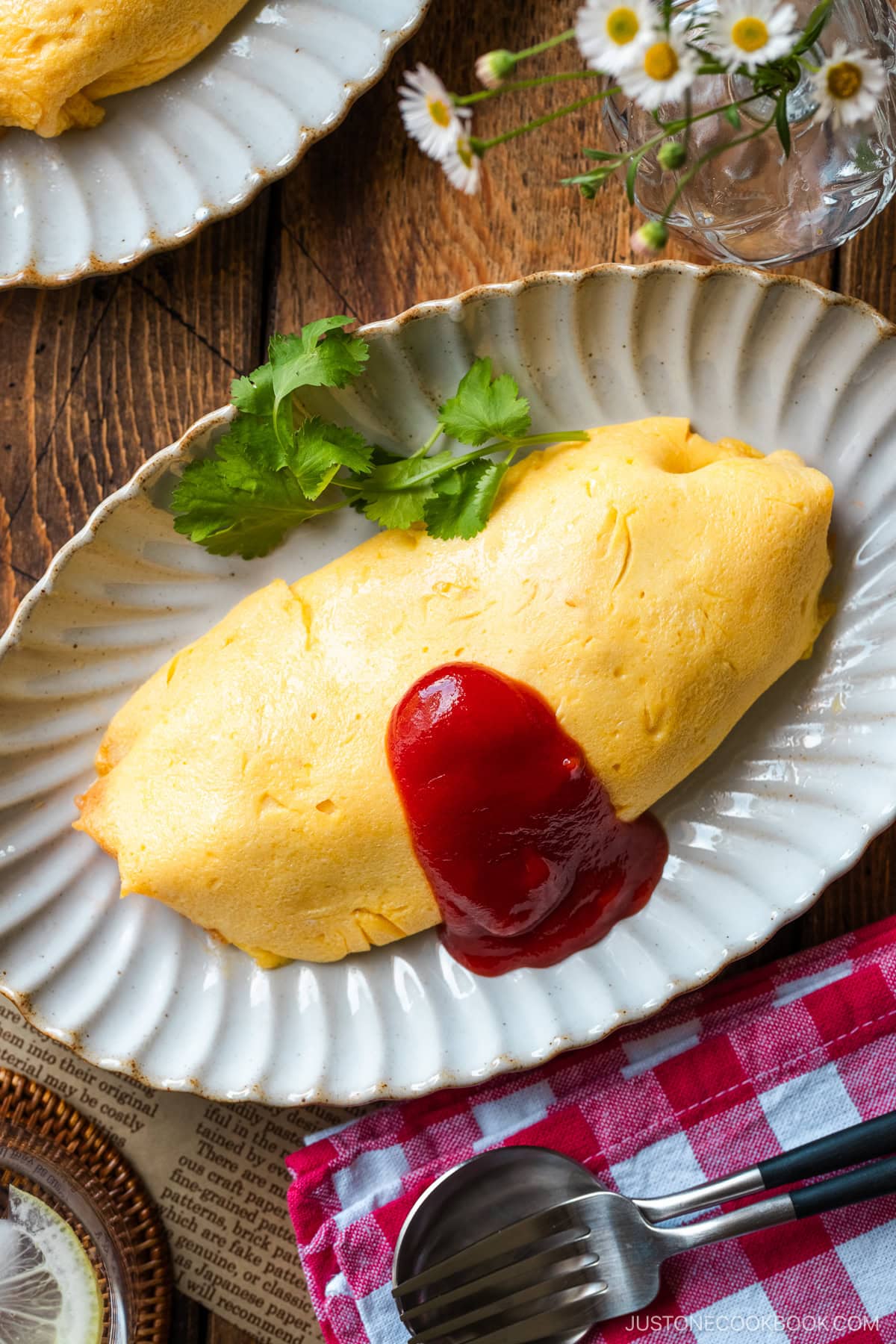
Recipe Tips and Techniques
- Use a small-size, nonstick skillet. I recommend an 8-inch (20 cm) nonstick frying pan. If you use a large pan, the egg will spread thin and you’re more likely to crack or tear the omelette. It’s also extremely hard to fold and flip when making a large omurice. I’ve tried using my favorite carbon steel pan, but it was very challenging to make an omelette with a smooth surface.
- Strain the beaten eggs. For a silky-smooth omelette, use a fine-mesh strainer to remove the two stringy bands on the yolk called the chalaza. This helps to give the cooked eggs a uniform texture.
- Shape the rice before you add it to the omelette using the side of a small bowl and a spatula. If you try to shape it into a half moon after adding it to the pan, you might tear the omelette. Proportioning also helps keep the omurice the same size. Gently spread the rice to the sides.
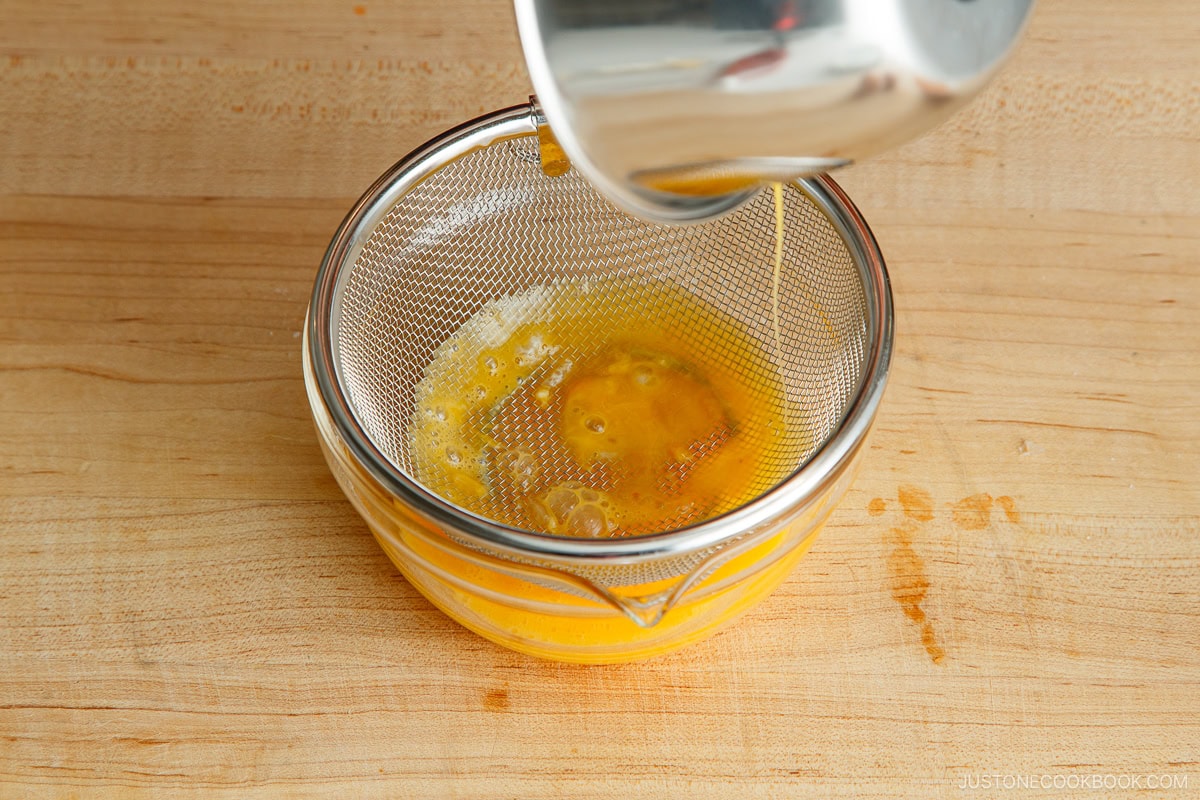
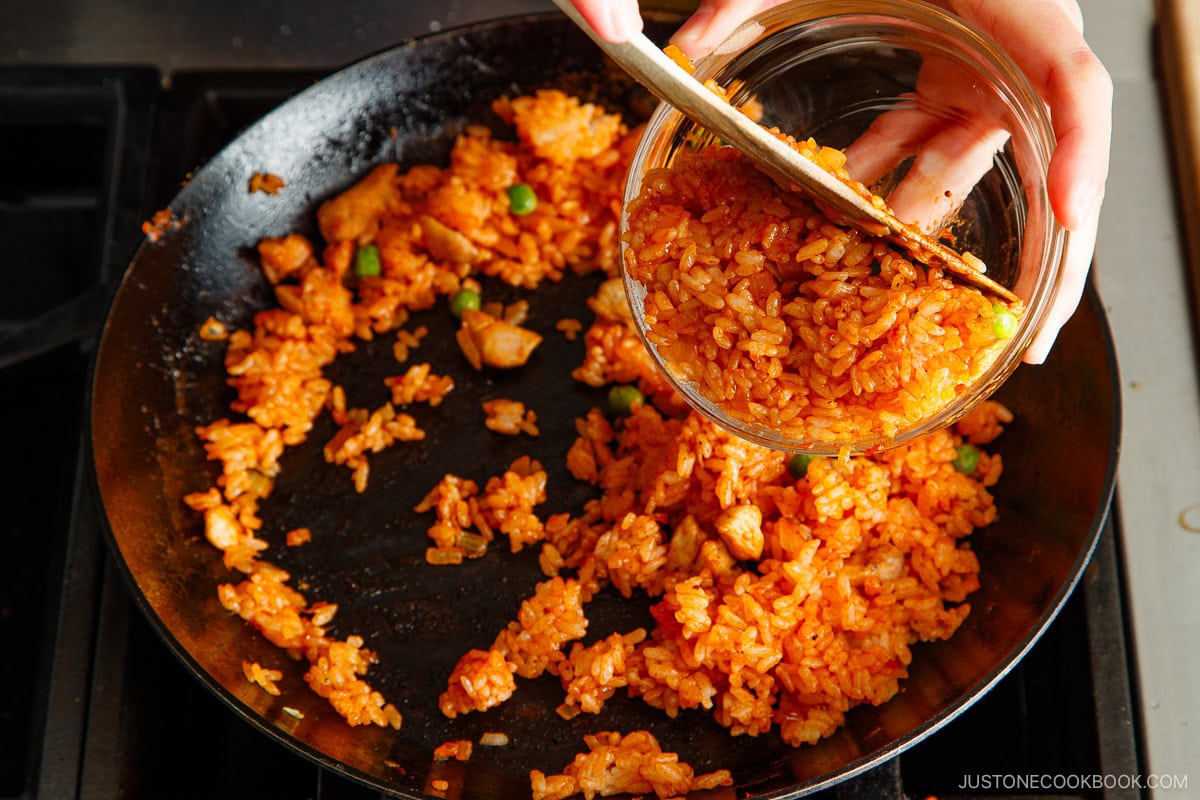
- Stir the eggs quickly in a spiral motion with chopsticks while you shake the pan. Keep the eggs moving so you end up with soft, small curds and an even exterior surface. I found that chopsticks can create really nice small curds better than a silicone spatula.
- Stop stirring when the eggs are half-cooked. You want to see a smooth omelette surface, not the chopsticks’ stirring marks. Therefore, stop stirring while the eggs are still rather runny. Tilt the frying pan to spread out the remaining uncooked egg mixture. The egg curds should look creamy, soft-scrambled, and custardy at this stage. You don’t want to overcook them, as they’ll continue to cook a little with the residual heat. Make sure to level the egg curds.
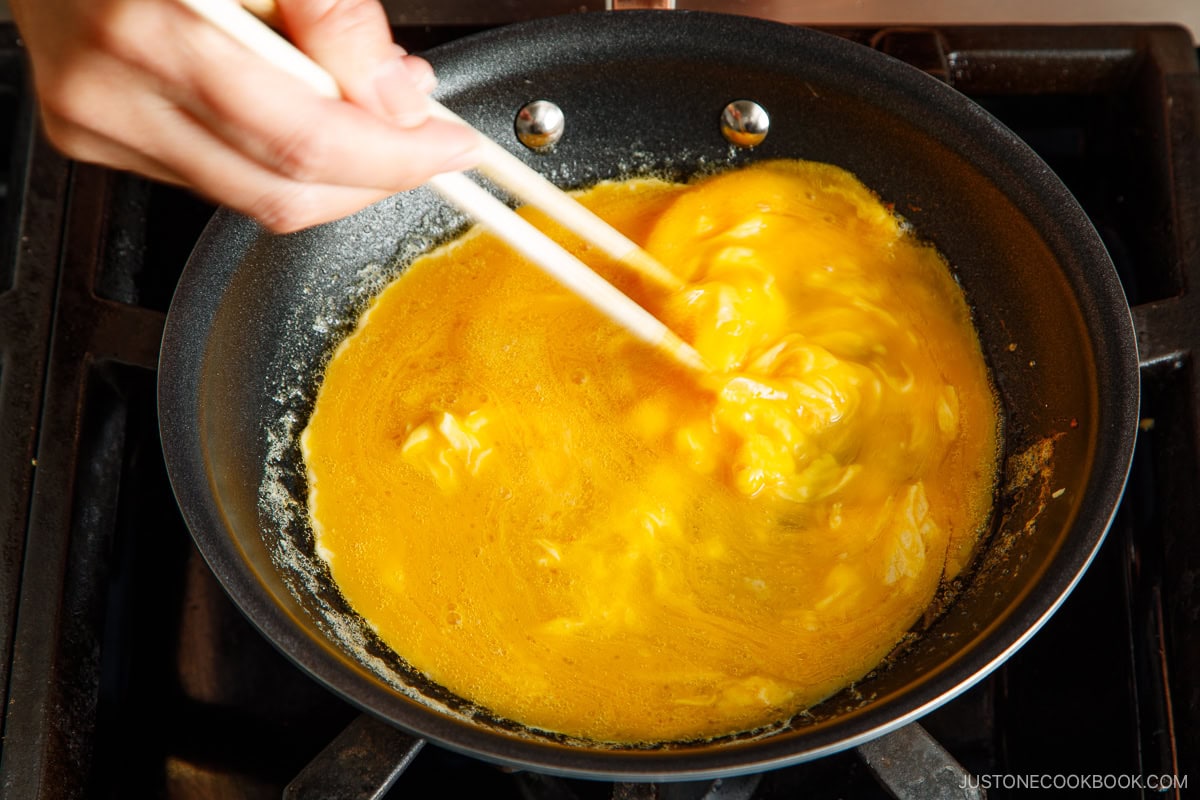
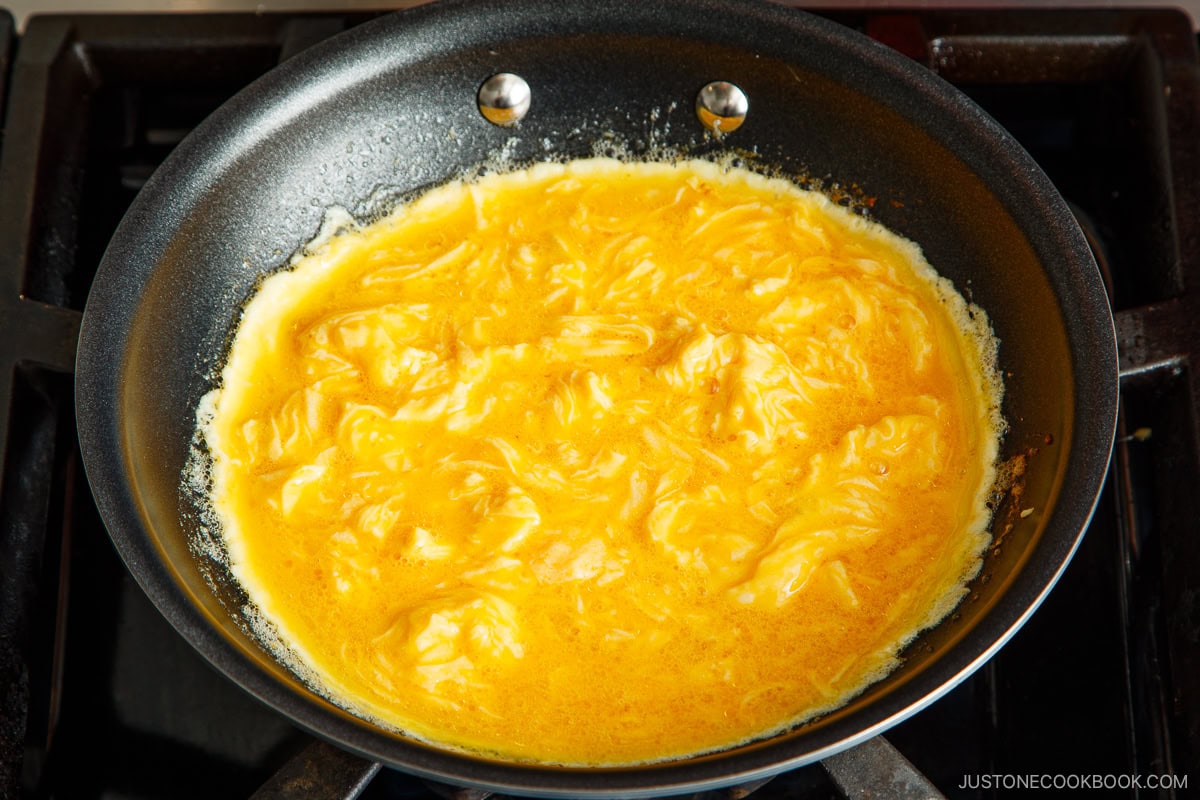
- When the eggs are half-cooked, place the chicken rice in the center of the omelette. Spread it out to the sides a little. Create a rough football shape without moving and touching the omelette.
- Move the pan to a wet folded cloth to cool it. This prevents the omelette from browning, ensuring that your omurice is an even pale yellow color. Then, slide the omelette to the far edge from the handle and wrap the rice with omelette from both sides.
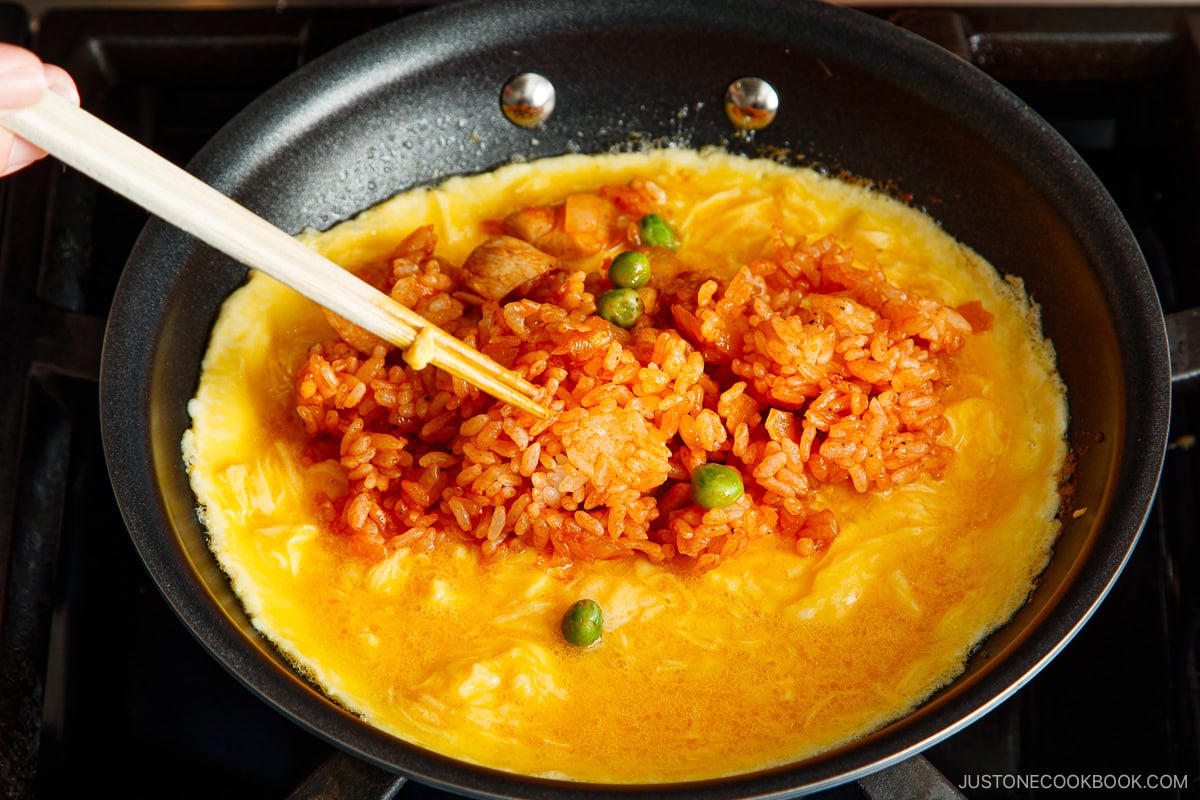
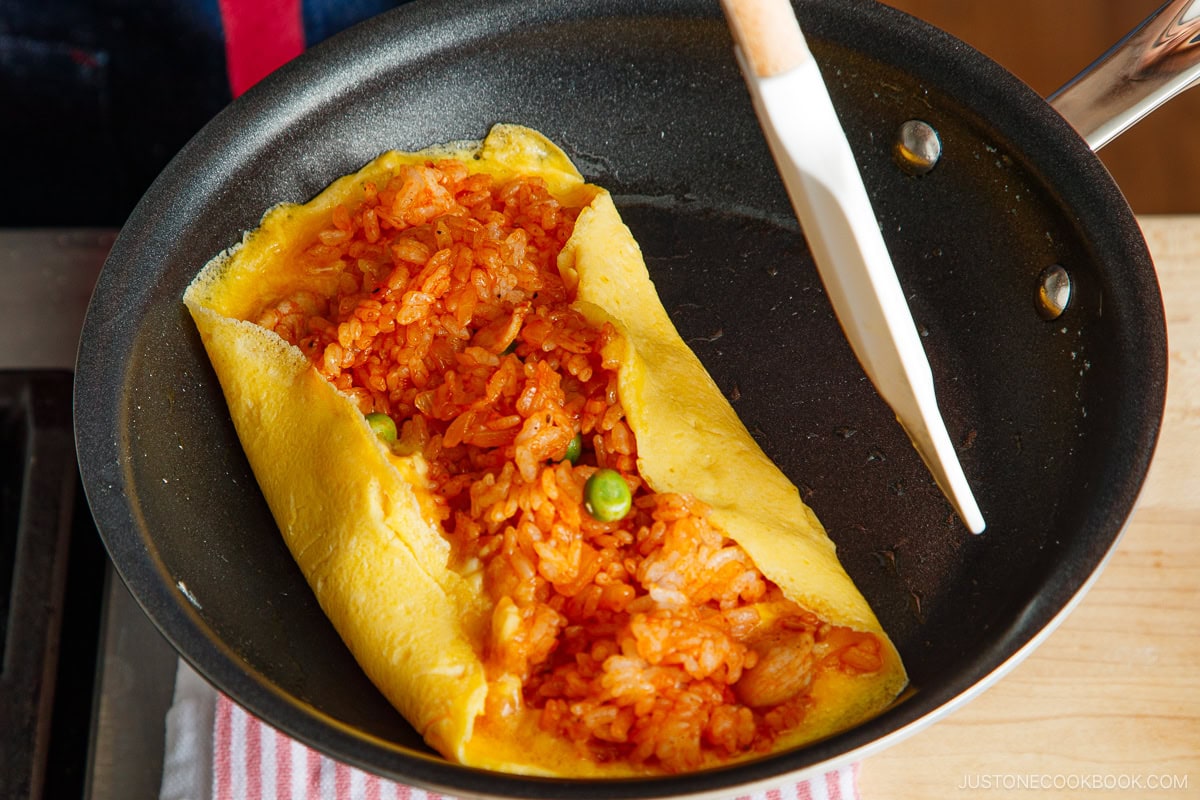
- Tilt a plate and hold the frying pan upside down at an angle to flip the omurice onto the plate.
- Use a paper towel to shape the omurice. Once you invert it onto a plate, place a paper towel on top and gently mold it with your hands into the shape of a rugby ball.
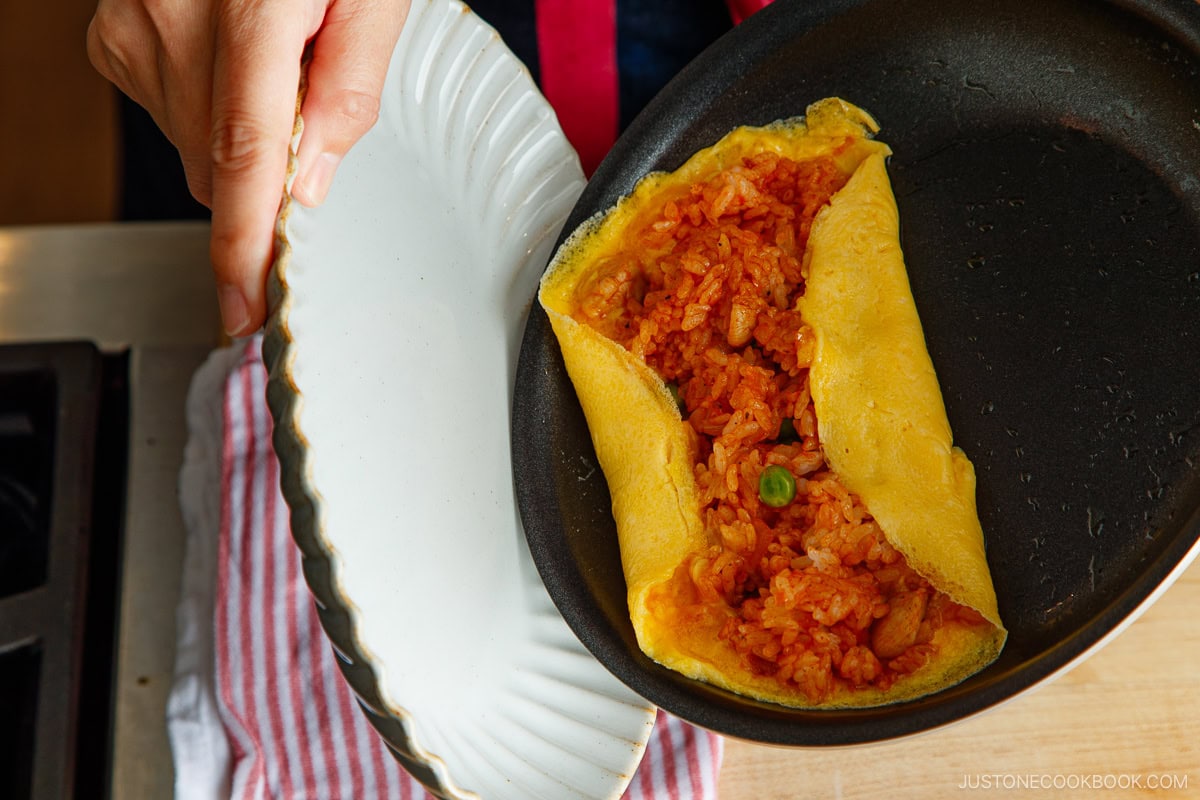
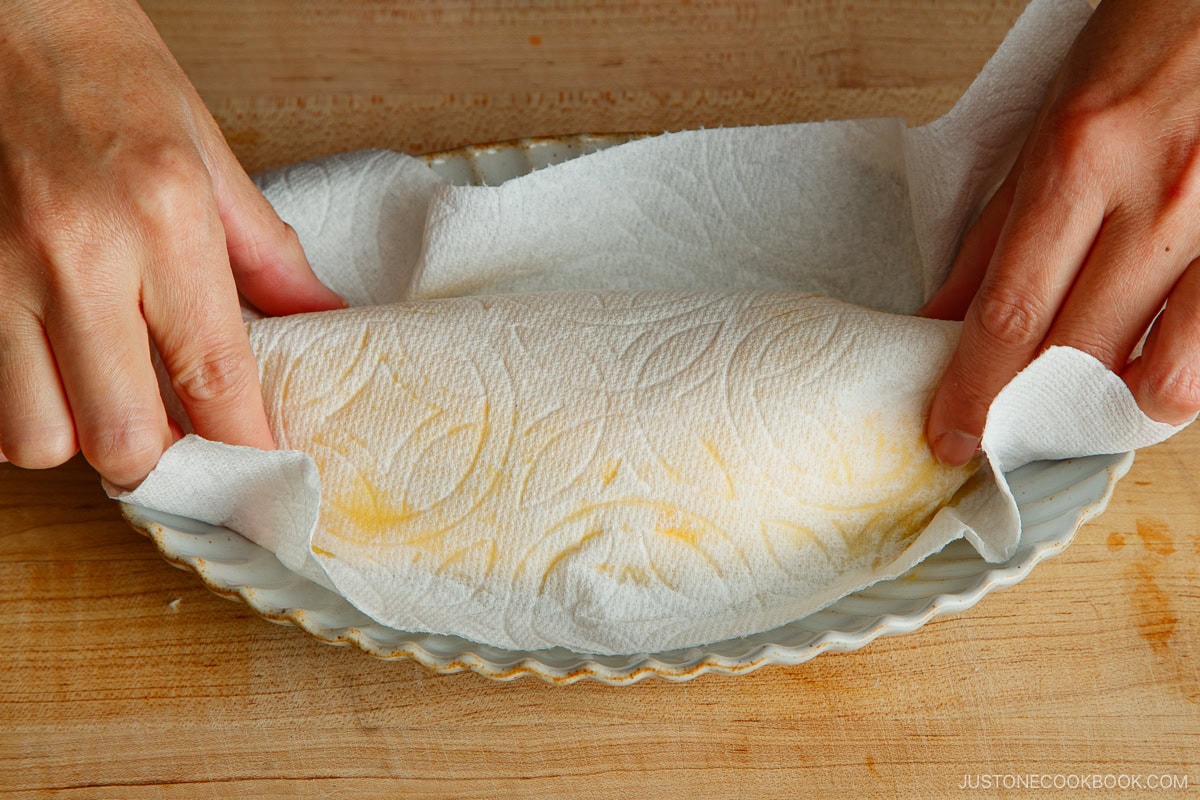
Do You Need an Omurice Pan?
An omurice pan is a small, deep frying pan that’s specifically designed to cook Japanese omelets. They’re meant to help with shaping your omurice and will usually have a nonstick surface.
While they can be helpful with this recipe, I like to use my All-Clad D3 8-inch Fry Pan, which is made from tri-ply stainless steel and bonded for fast, even heating. It’s on the pricier side at around $130, but I think it’s definitely worth it since it’s compatible with any stovetop, has a top-quality nonstick coating, and is completely warp-resistant.
Making the Chicken Rice in a Rice Cooker
You can make the chicken rice in an electric rice cooker. The recipe is coming soon!
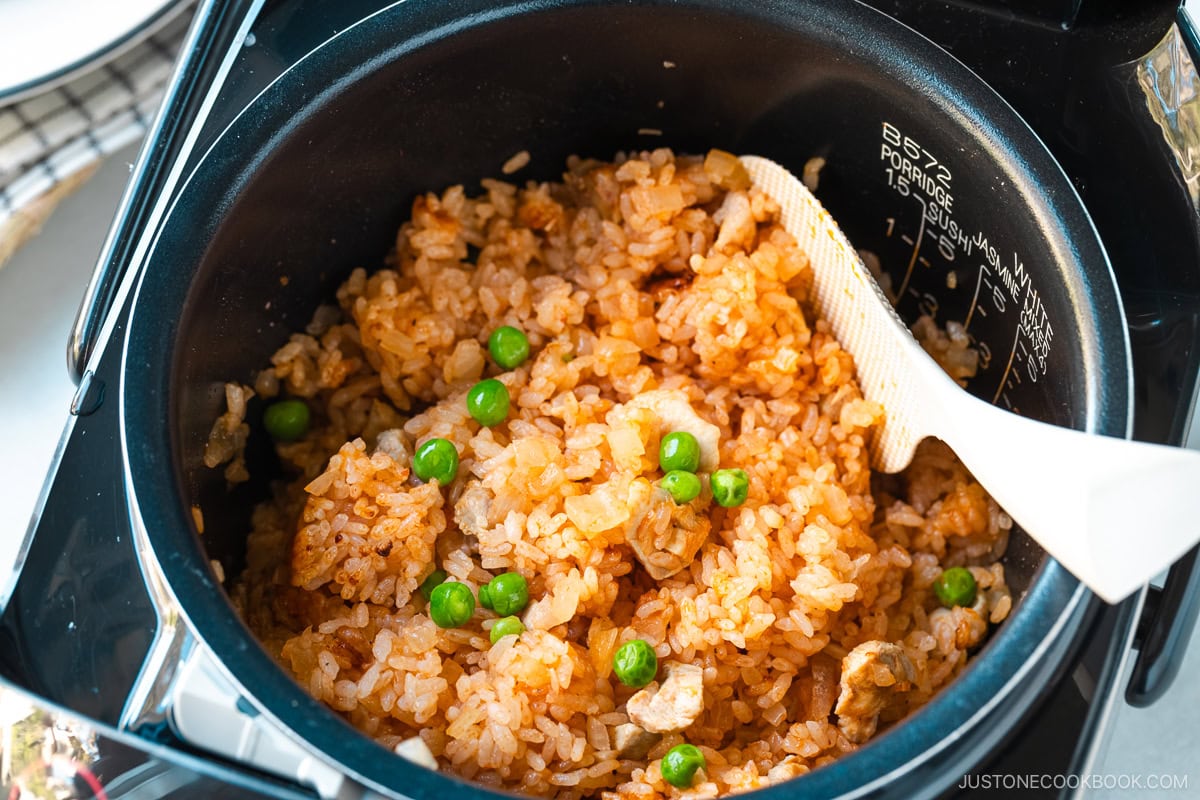
Feel free to make this rice cooker chicken rice ahead and freeze individual portions, so you can make omurice whenever you want to eat it.
How to Store
- To Store: You can keep the leftovers in an airtight container and store in the refrigerator for up to 3 days or in the freezer for a month.
- To Reheat: Microwave until warm.
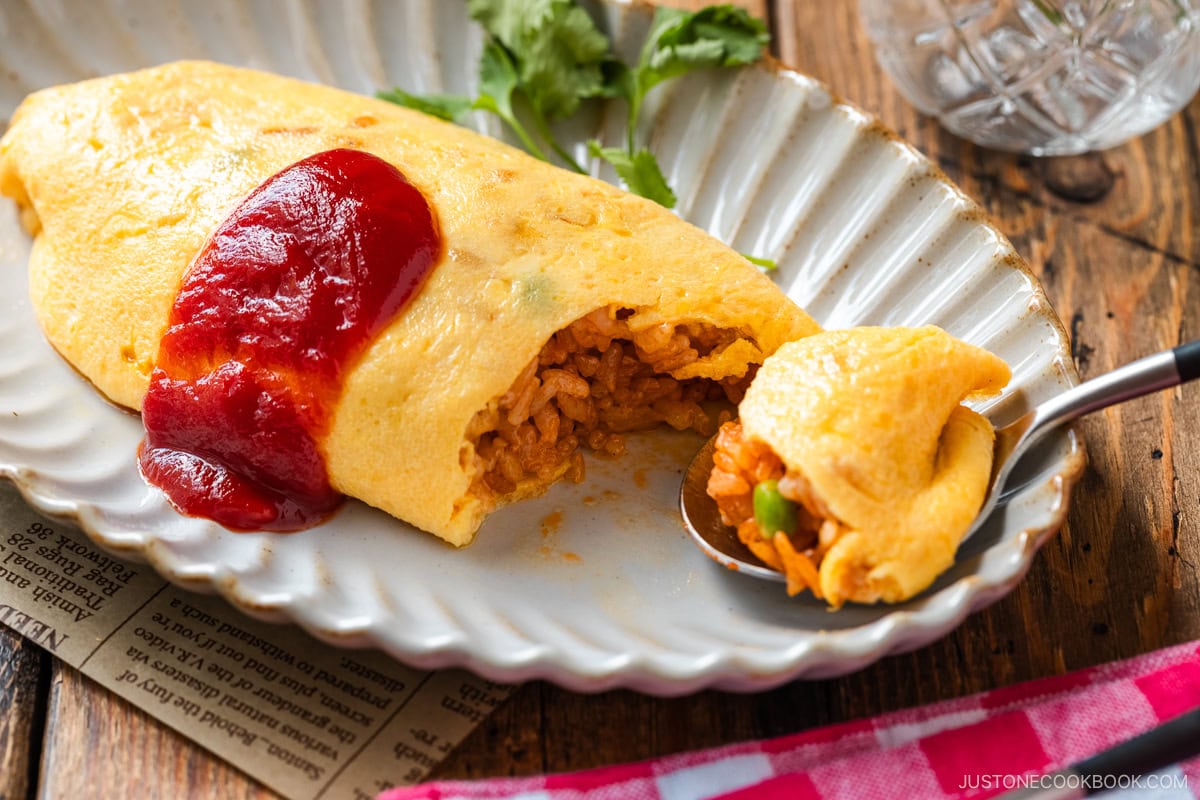
What to Serve with Omurice
- Soup – Bacon and Asparagus Miso Soup or Corn Potage
- Salad – Apple Walnut Salad or Japanese Kani (Crab) Salad
- Sides – Green Beans with Yuzu Vinaigrette or Miso Butter Mushrooms
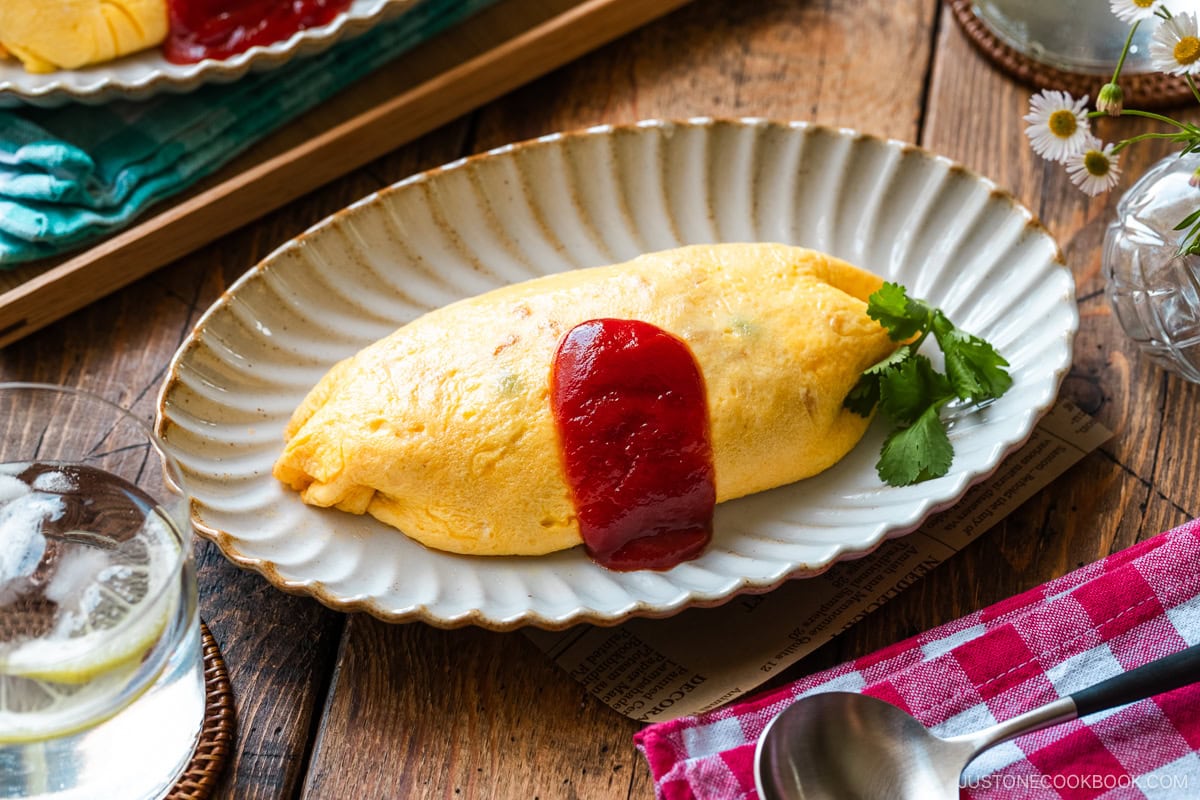
Wish to learn more about Japanese cooking? Sign up for our free newsletter to receive cooking tips & recipe updates! And stay in touch with me on Facebook, Pinterest, YouTube, and Instagram.
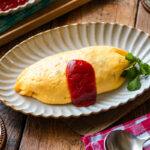
Omurice (Japanese Omelette Rice)
Video
Ingredients
For the Chicken Rice
- ¼ onion (4 oz, 113 g)
- 3 oz boneless, skinless chicken thigh
- 1 Tbsp unsalted butter
- 1 Tbsp green peas (cooked)
- ½ tsp Diamond Crystal kosher salt (divided)
- freshly ground black pepper
- 2 servings cooked Japanese short-grain rice (1¾ cups, 330 g; warm)
- 5 Tbsp ketchup (plus more for garnish; for an authentic taste, I highly recommend KAGOME brand Japanese ketchup)
- 1 tsp Worcestershire sauce
For the Omelettes
- 4 large eggs (50 g each w/o shell) (divided)
- ½ tsp Diamond Crystal kosher salt (divided)
- 2 Tbsp unsalted butter (divided)
Instructions
- Before You Start: For the chicken rice, you can use reheated frozen rice if you have it. See how to cook Japanese rice with a rice cooker, pot over the stove, Instant Pot, or donabe.
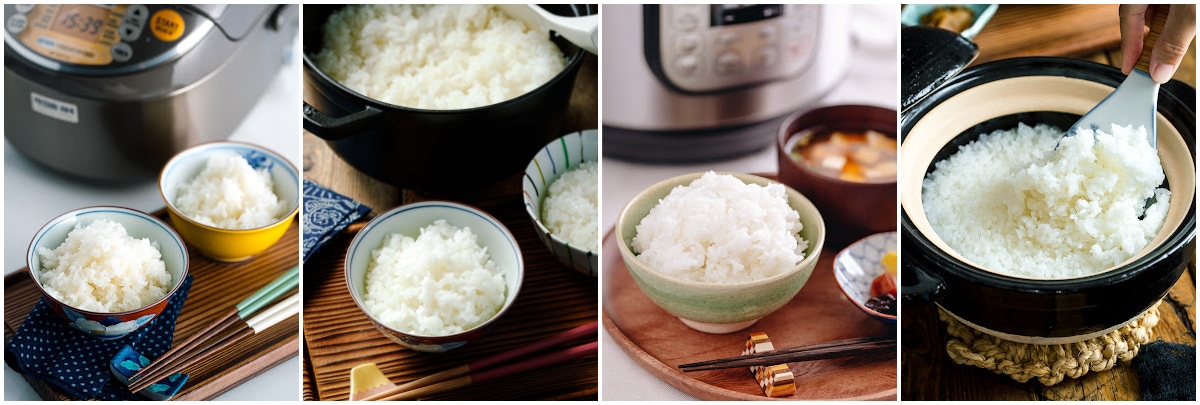
- Gather all the ingredients.
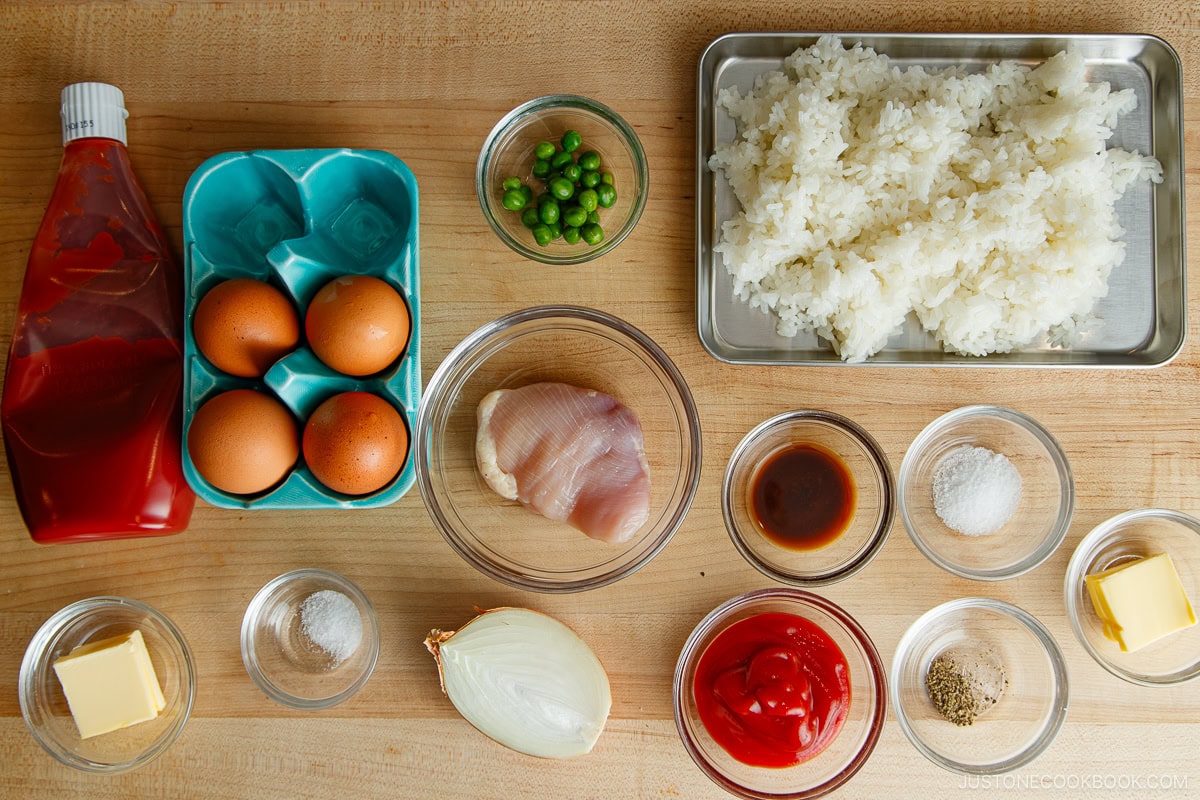
To Make the Chicken Rice
- Lay ¼ onion flat side down on the cutting board. With the knife edge toward the root end, make ⅛-inch horizontal slices to within ½ inch of the root end, keeping the root intact. Then, make ⅛-inch vertical slices, again keeping the root intact.
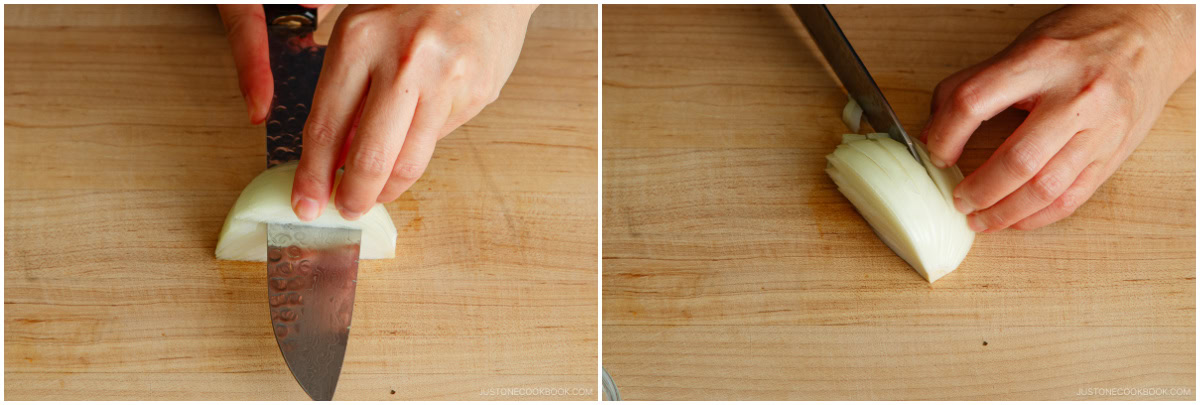
- Mince finely into ⅛-inch (3-mm) pieces. If you need to chop the onion pieces finer, run your knife through them using a rocking motion. Hold down the tip of the knife; otherwise, the onions will go flying around the room.
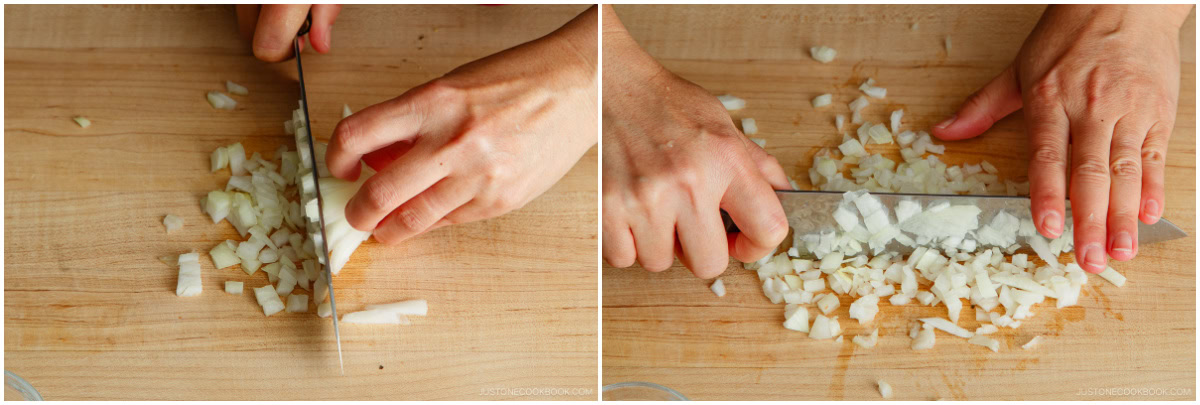
- Angle your knife back and diagonally, and then slice 3 oz boneless, skinless chicken thigh along the grain into strips about ½ inch (1.5 cm) wide. Next, angle your knife again and slice the chicken strips against the grain into pieces about ½ inch (1.5 cm) square. This sogigiri cutting technique gives the chicken pieces equal thickness and creates more surface area for fast cooking and better absorption of the flavors.
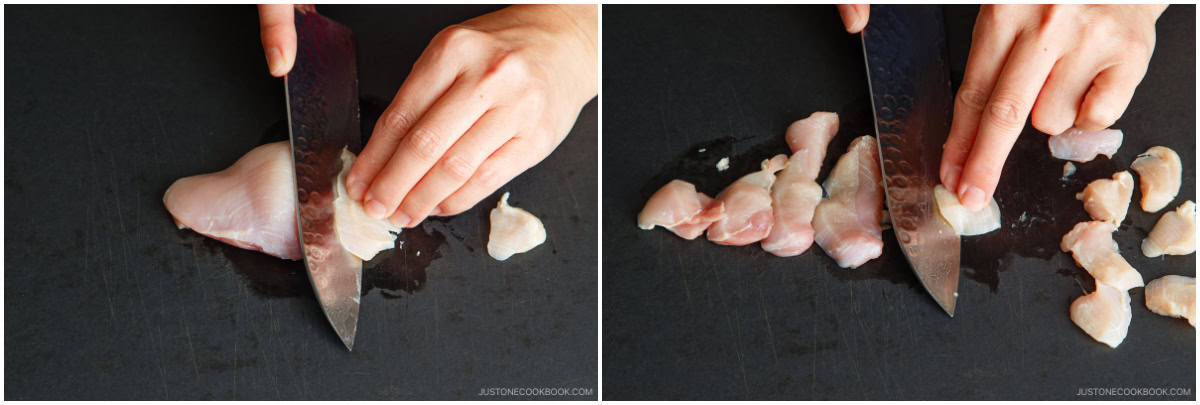
- Heat 1 Tbsp unsalted butter in a large frying pan over medium heat and add the minced onion.
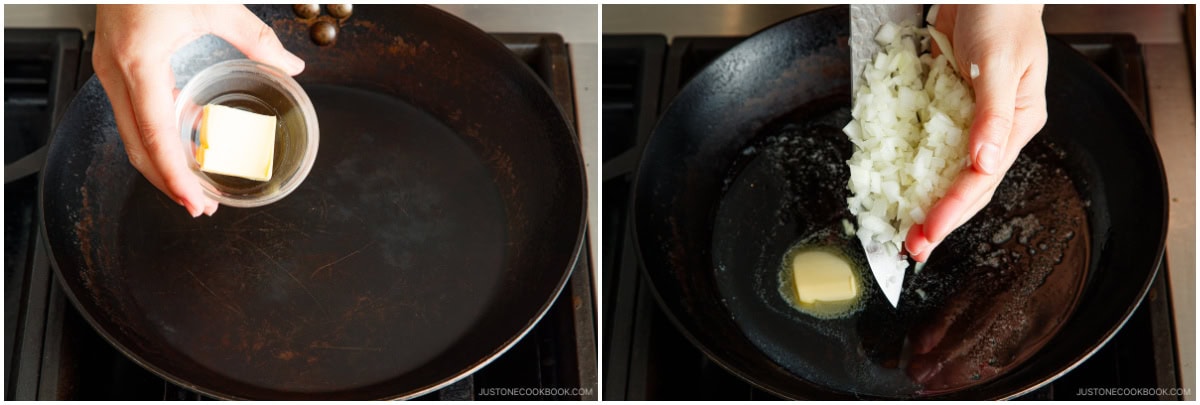
- Sauté the onions until tender.
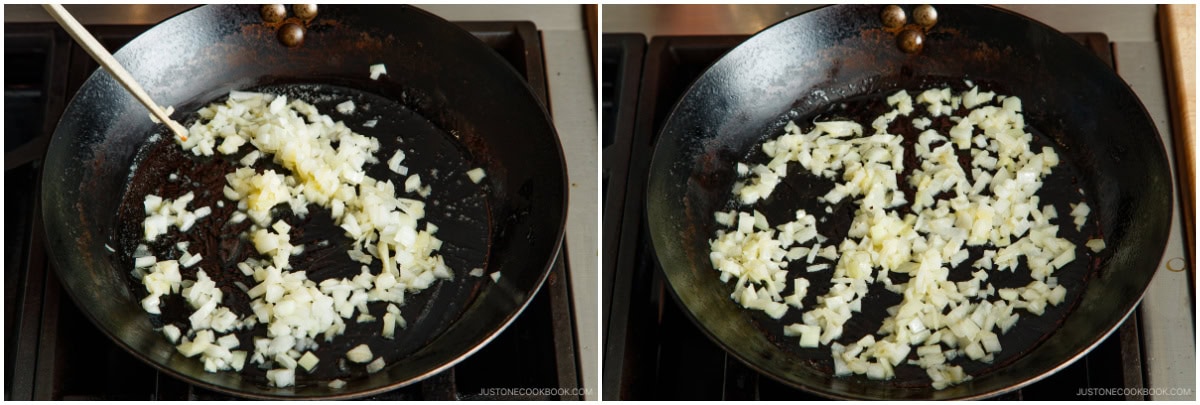
- When the onions are tender, add the chicken and season it with half of the Diamond Crystal kosher salt and freshly ground black pepper.
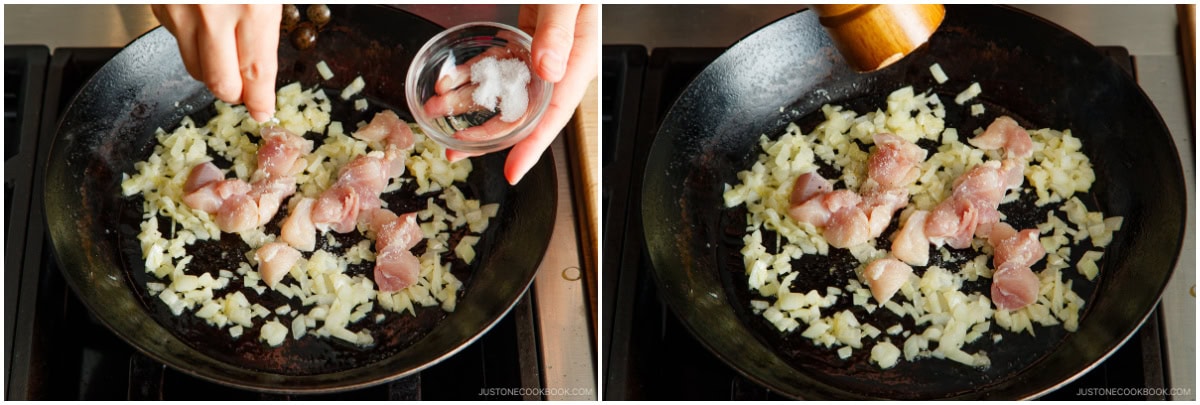
- Cook the chicken until it‘s no longer pink.
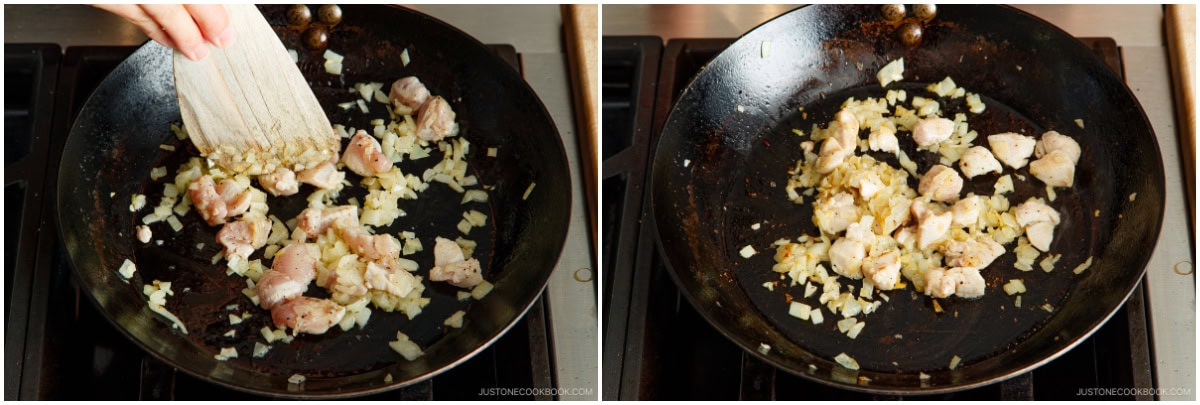
- Reduce the stove‘s heat a little and add 5 Tbsp ketchup and 1 tsp Worcestershire sauce and stir to combine. Let the excess moisture evaporate so the rice will not become mushy.
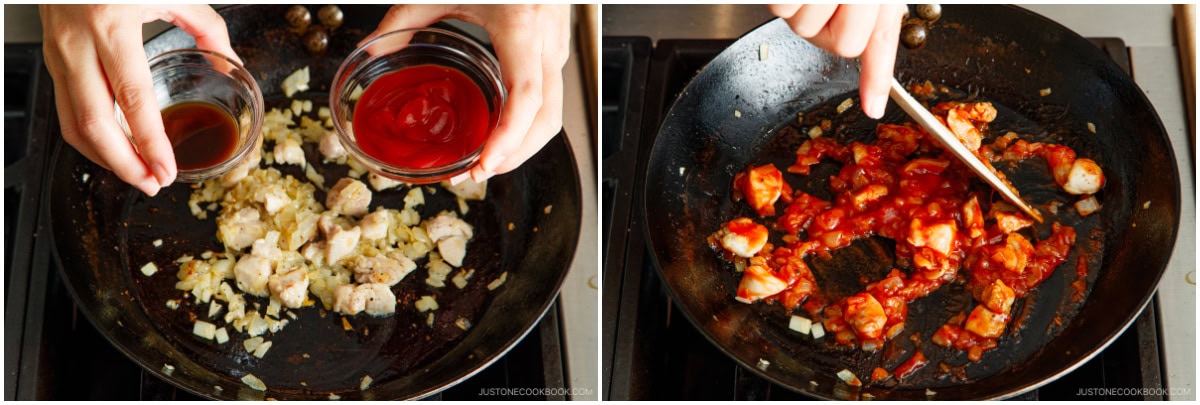
- Add 2 servings cooked Japanese short-grain rice. Use a cutting motion with your spatula to break the clumps into small pieces.
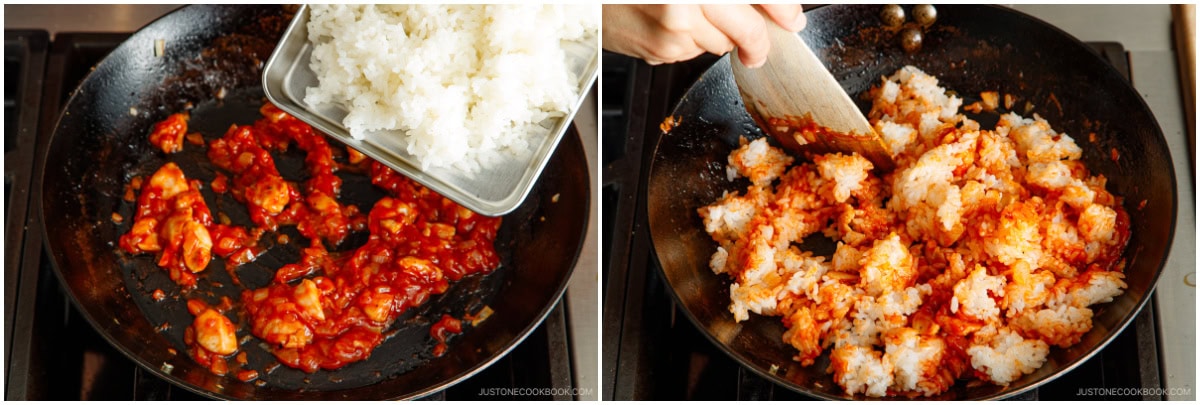
- Season with remaining half of the Diamond Crystal kosher salt and freshly ground black pepper.
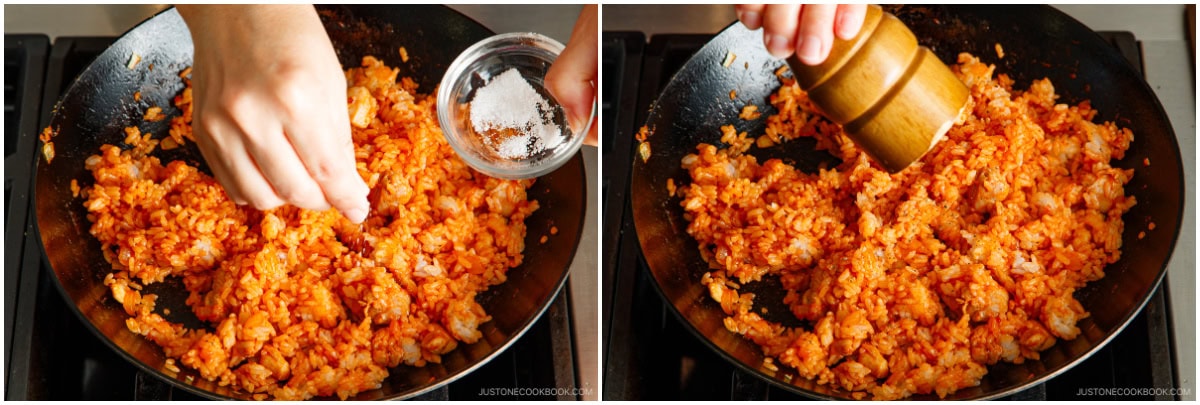
- Add 1 Tbsp green peas and toss to combine. Remove from the heat. Divide the chicken rice into 3 portions; use 2 portions today and freeze the extra portion to use next time. Set aside. You will shape the rice before you add it to the omelette using the side of a small bowl and spatula.
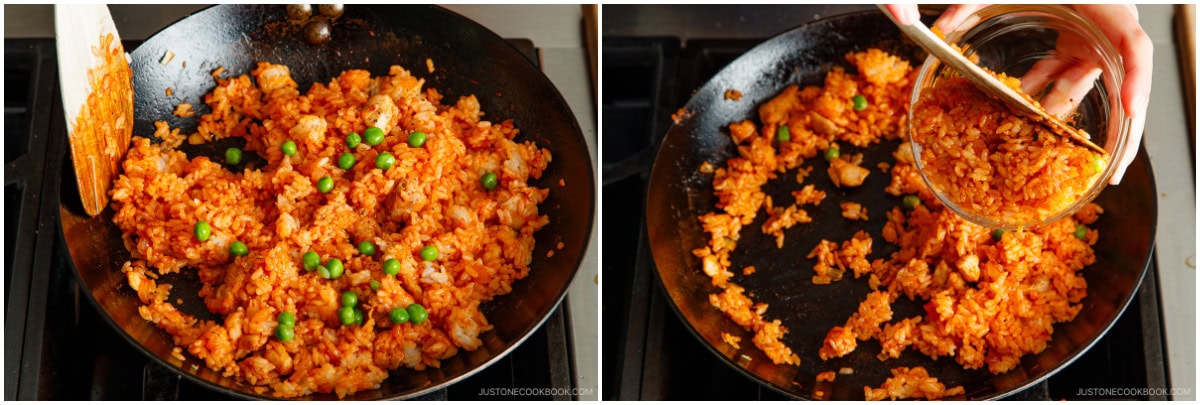
To Make the Omurice
- We‘ll make the omurice one at a time. Crack 2 large eggs in a small bowl. Using chopsticks, beat the eggs in a zigzag motion while you keep the chopsticks' tips touching the bowl's bottom. Cut the egg whites instead of whisking.
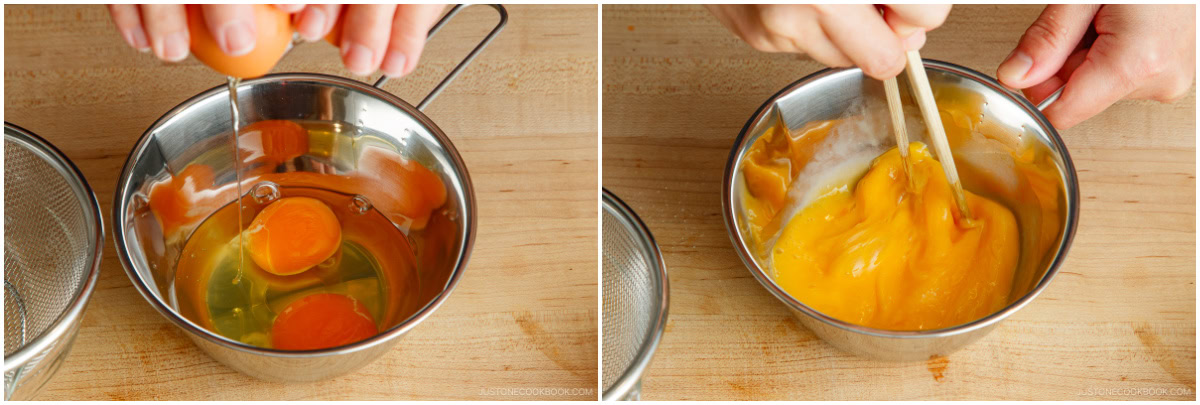
- Add ¼ tsp Diamond Crystal kosher salt. Then, strain the beaten eggs through a fine-mesh strainer. This removes the stringy bands on the yolks called the chalaza to give the cooked eggs a uniform and silky-smooth texture.
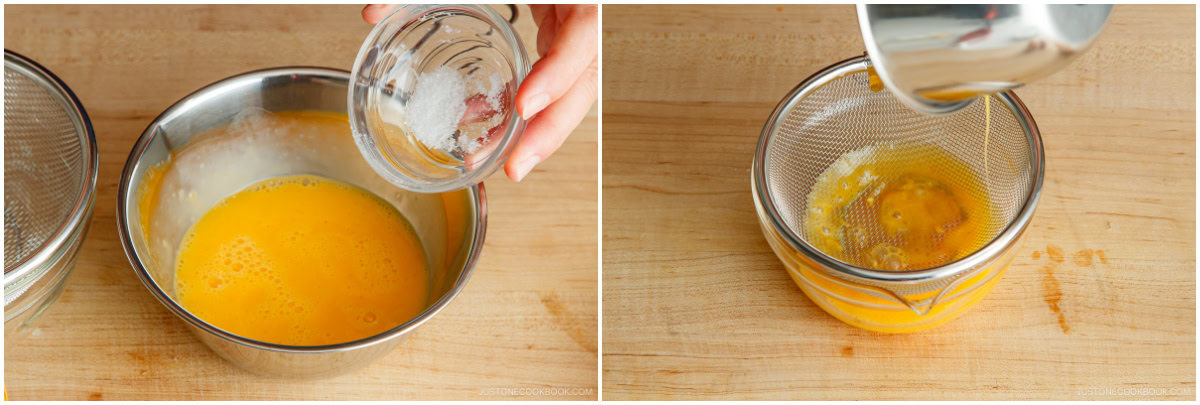
- Heat 1 Tbsp unsalted butter in the pan over medium heat. Distribute the butter to make sure the surface of the pan is coated well.
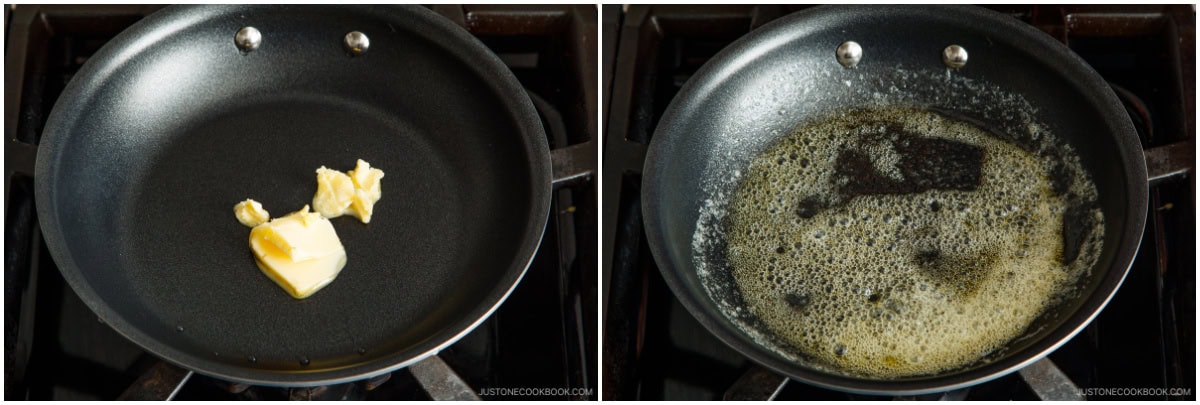
- Check if the pan is hot by adding a drop of the egg mixture into the pan with a chopstick. If it sizzles, then pour in the egg mixture.
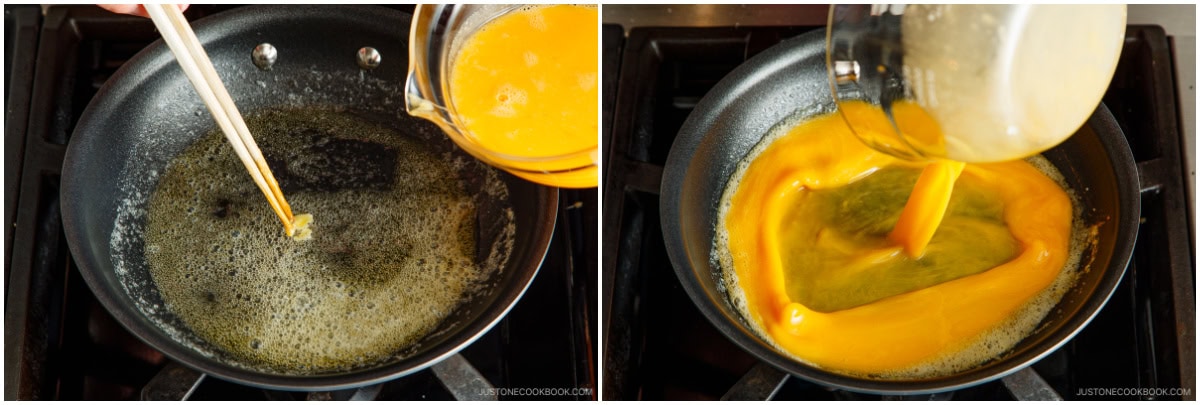
- Stir the eggs quickly in a spiral motion with chopsticks while you shake the pan. Keep the eggs moving so you end up with soft, small curds and an even exterior surface. I found that chopsticks can create really nice small curds better than a silicone spatula.
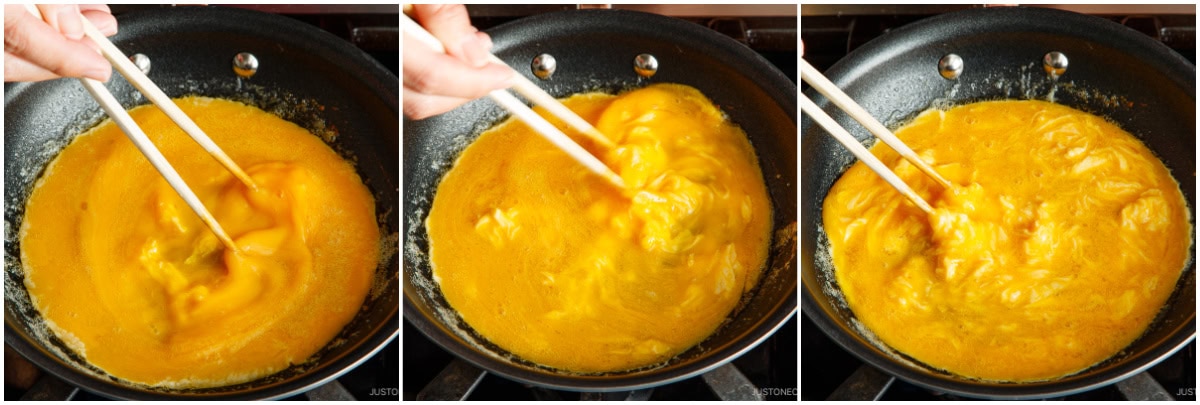
- Stop stirring when the eggs are half-cooked. You want to see a smooth omelette surface, not the chopsticks’ stirring marks, so stop stirring while the eggs are rather runny. Tilt the frying pan to spread out the uncooked egg mixture. The egg curds should look creamy, soft-scrambled, and custardy at this stage. You don‘t want to overcook them, as they’ll continue to cook a little with the residual heat. Make sure to level the egg curds.
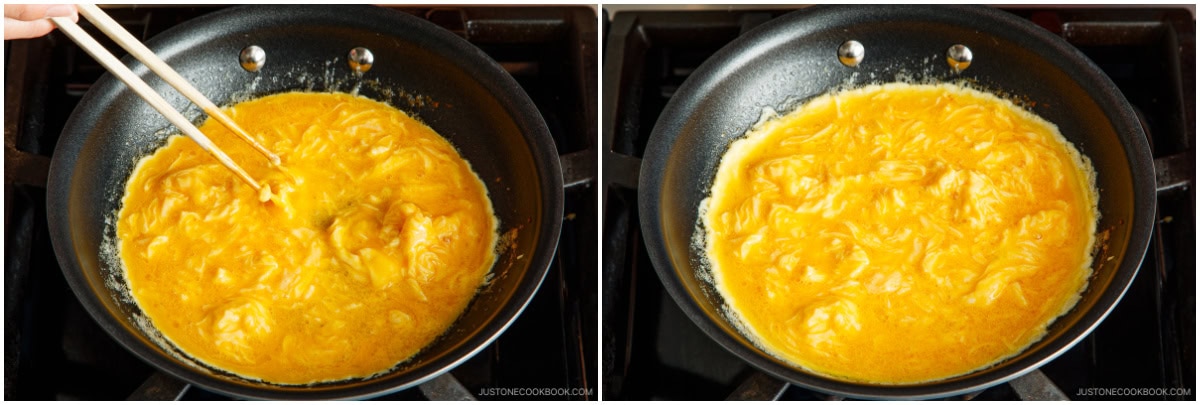
- Place 1 portion of chicken rice in the center of the omelette. Spread it out to the sides a little. Create a rough football shape without moving and touching the omelette. Turn off the stove‘s heat.
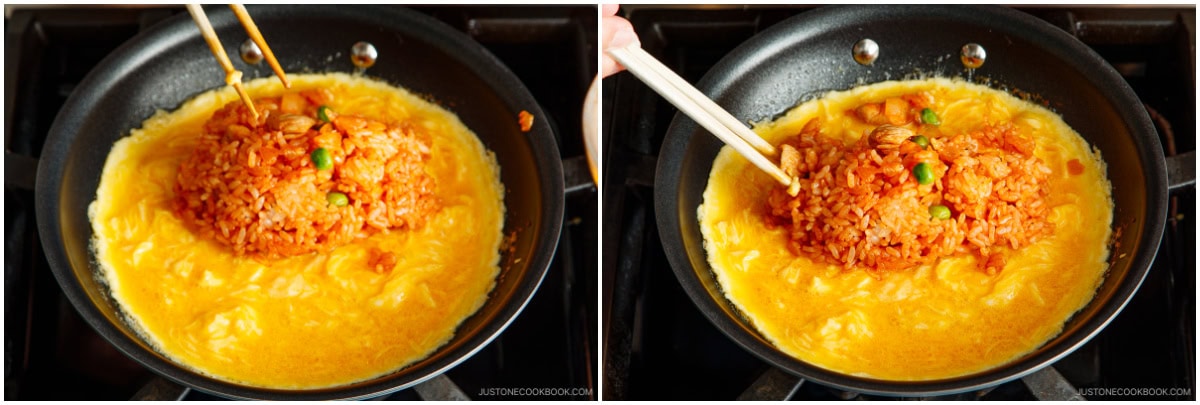
- Move the pan to a wet folded cloth to cool it. This keeps the omelette from browning so that your omurice is an even pale yellow color. Then, slide the omelette to the far edge of the pan. Wrap the rice with the omelette from both sides.
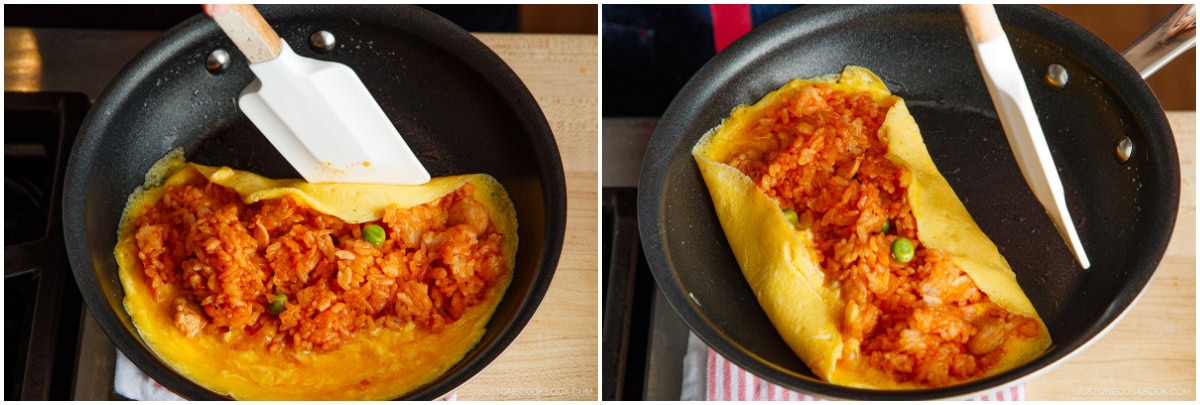
- Hold a plate in one hand and the pan in the other and tilt the plate next to the omurice. Then, flip the frying pan upside down at an angle to transfer the omurice, seam side down, onto the plate.
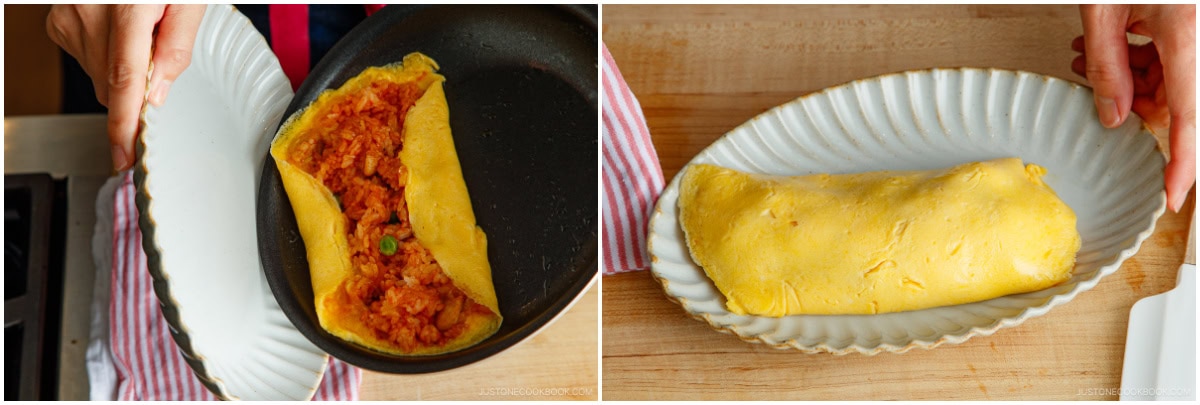
To Serve
- Place a paper towel on top of the omurice and gently mold it with your hands into the shape of a football or rugby ball. Drizzle additional ketchup on top or in a zigzag pattern. Enjoy!
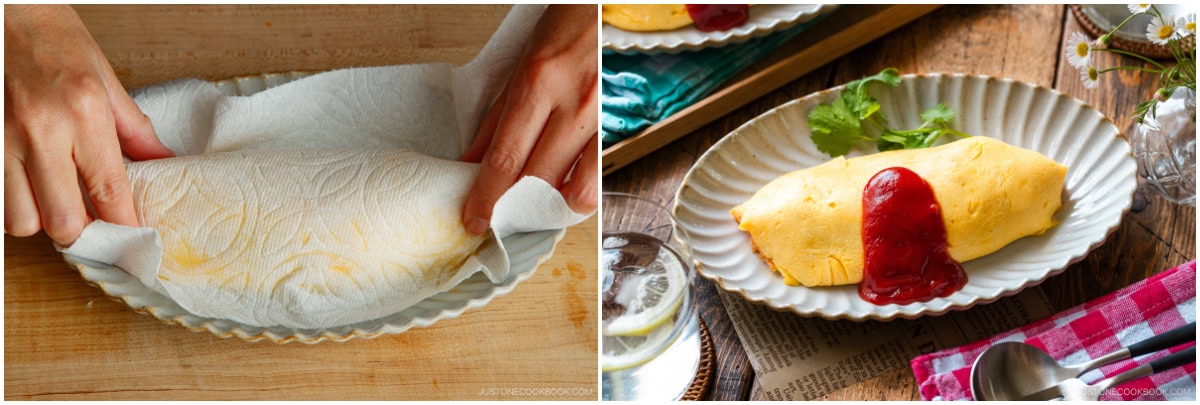
To Store
- You can keep the leftovers in an airtight container and store in the refrigerator for up to 3 days or in the freezer for a month.
Equipment
Nutrition
Editor’s Note: This post was originally published on August 14, 2012. It was updated with a revised recipe, more helpful content, and new images on May 7, 2024. A new video was added on November 15, 2024.
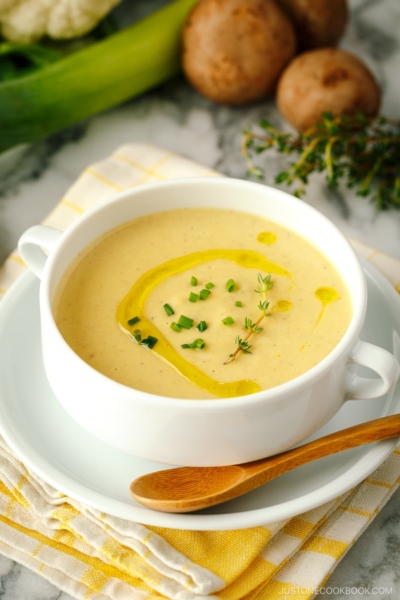

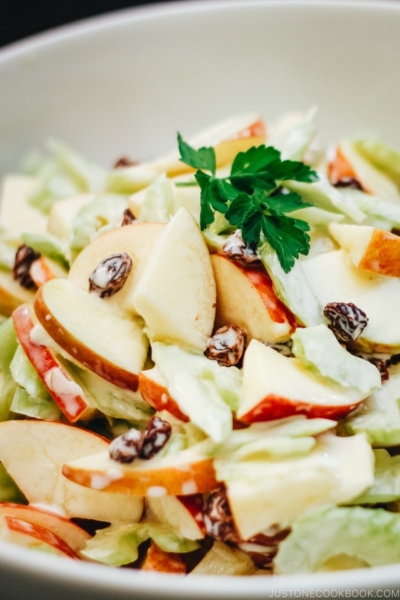
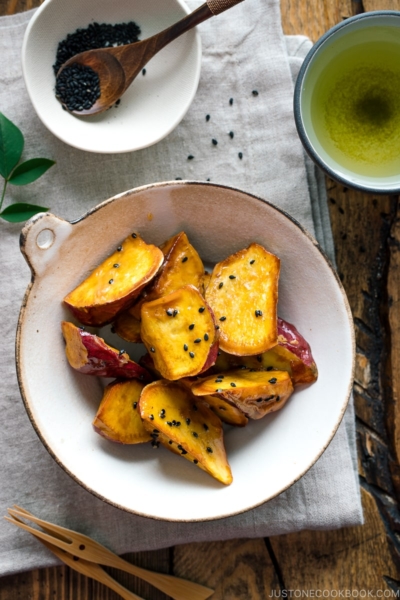
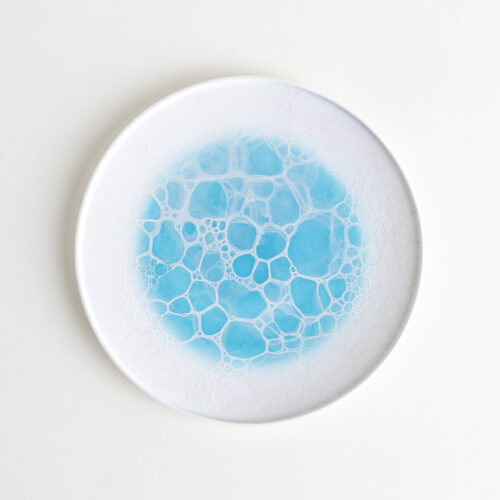
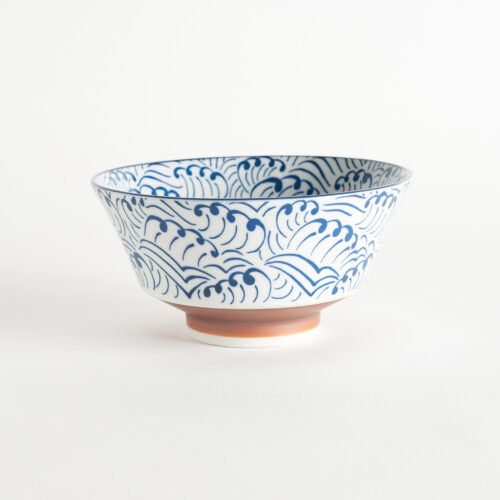
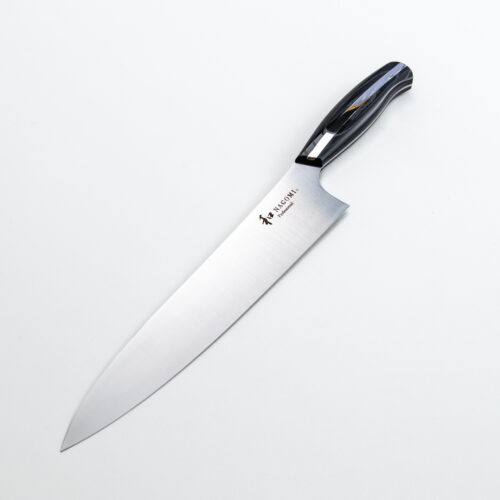
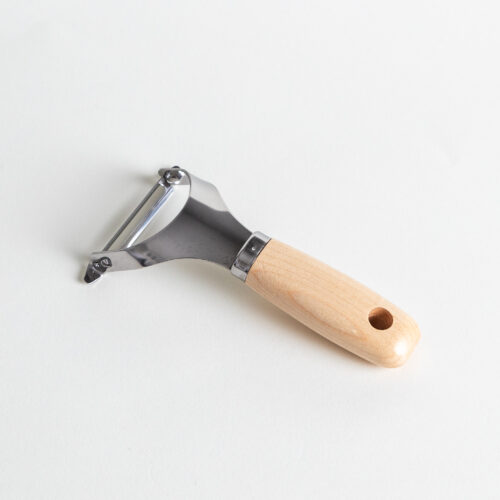
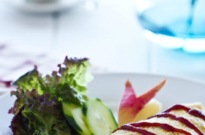
Hello! I have a question about the frying pan. I need the total diameter of the pan to be 20cm, or only frying area? I’m sorry if my question is not clear.
Hi Haruka! Thank you for trying Nami’s recipe.
It is the diameter of a pan and the measurement across the top rim to rim. Hope this helps!🙂
This was amazingly fun and good. Thanks for sharing your recipe!
Hello Kap! We are so happy to hear you enjoyed Nami’s recipe!
Thank you for taking the time to rate her recipe. Happy Cooking!
I’m going to sound so silly but I can’t use chopsticks I’ve tried to use them but my fingers don’t want to work with me is there a way to make this without using chopsticks 🥲
Hello, Rachel. Thank you for trying Nami’s recipe.
Don’t worry! You can use forks or silicone spatula. We hope you’ll enjoy this dish!😃
Thanks for the recipe! I’ve tried a couple different variations but I like this one best! I love trying out recipes from other countries it’s like a taking a mini vacation and trying out the local cuisine. One day I’ll get to go to Japan for real and try out all the local dishes in person.
Hello, Derrioc. Aww. We are pleased that you think Nami’s recipe is the best. And we like how you think about trying different countries’ cuisines!
We hope you enjoy our travel and culture posts too. ☺️
Travel:
https://www.justonecookbook.com/categories/travel/
Culture:
https://www.justonecookbook.com/categories/japanese-culture/
The overall recipe is delicious, but the cheese and olive oil didn’t work out for me. I omitted the cheese all together and swapped oil with butter. It turned out soo good!
Hello, Eiri! Thank you for experimenting with Nami’s recipe!
We are relieved to hear that everything worked out in the end. Thank you for your feedback!
This is a weird version of the Japanese omurice I grew up with in Osaka. Cheese?!?!
Hi Emi! Thank you for reading Nami’s post and trying her recipe!
Yes! Cheese! Nami use shredded sharp cheddar cheese, but it can be any kind.
We hope you will give it a try!🙂
Thank you for the amazing recipe! One quick question: is the calorie number for one singular serving of omurice, or for two as the recipe yields? Thanks 🙂
Hi Kathryn, Thank you very much for your kind feedback!
The nutrition information is for approximately one serving with sauce.
We hope this helps!
Thank you so much for this recipe, we love it and especially being able to use leftovers inside – so yummy and now a regular lunchtime dish for us!
We used leftover soboro don – so gorgeous I might be making it especially for omurice 🙏
Hi Jill! Nami and JOC team are so happy to hear you enjoyed Omurice!
Thank you very much for trying Nami’s recipe and for your kind feedback.
Happy Cooking!🥰
Thank you for the recipe! I’d always wanted to try this, but I finally got around to it. It was pretty good! I enjoyed it, and I’ll make it again. I’ve been trying to eat healthier, and this seemed like a good option. I didn’t know how long to cook the egg to get it right since I haven’t made an omelette before. I wasn’t sure what a set bottom but soft top looked like. I ended up overcooking the egg, but it still turned out delicious. I also added a bit more ketchup and soy sauce than the recipe said since the rice tasted a little bland to me. Either way, it was delicious. Thank you so much! I’ll definitely be trying more of your recipes in the future!
Hi Ria! Thank you very much for trying Nami’s recipe!
When the edge of the egg starts to dry out, the bottom is most likely set. But the top should be soft still at the time when you add the cheese.
We hope this helps with your next try! Happy Cooking!